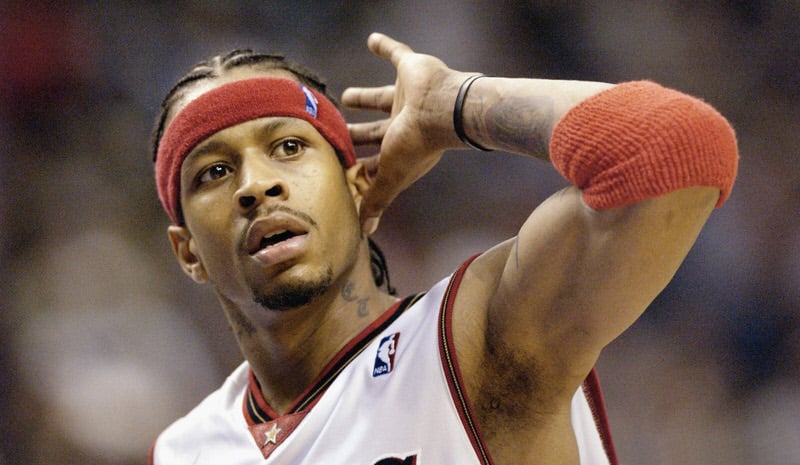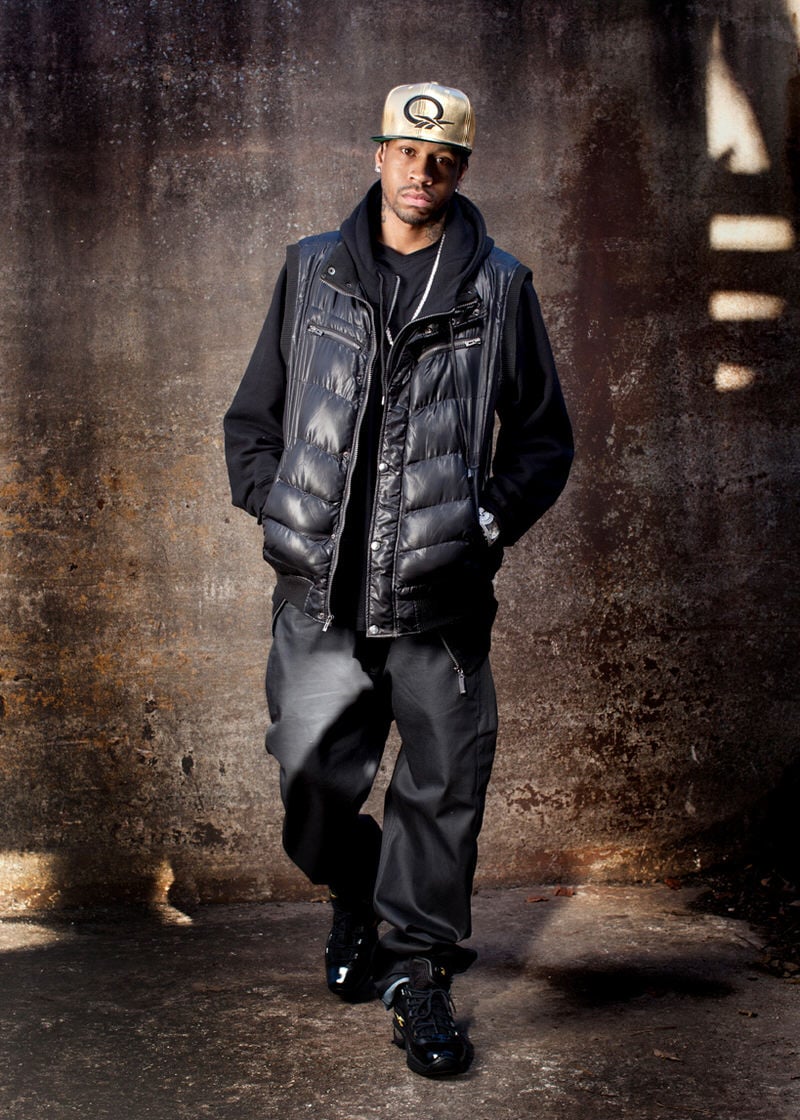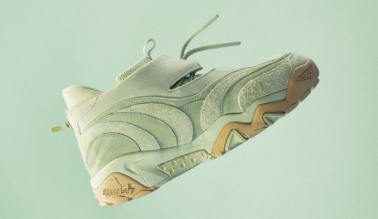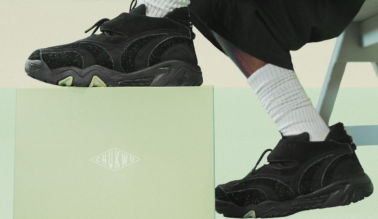This post may contain affiliate links. Please read our disclosure policy.
Allen Iverson turning 40 just doesn’t sound right.
The seemingly forever youthful superstar we’ve known as The Answer might be officially celebrating his 40th birthday today, but there’s been cause to celebrate for more than twenty years. Over the past two decades, he’s enjoyed a rise to icon status during a time in which the perfect storm of sports, music, hip-hop, and entertainment all came together.
To get the definitive account of Allen Iverson’s journey through the NBA and his landmark deal with Reebok, I spoke with key stakeholders through a series of more than twenty interviews. Each person is identified by name and then-affiliation and shared countless never-before-heard stories and memories of Allen.
The following is an 11-chapter oral history of the collective rise of Allen Iverson and Reebok Basketball, detailing the two-decade-long partnership and ride.
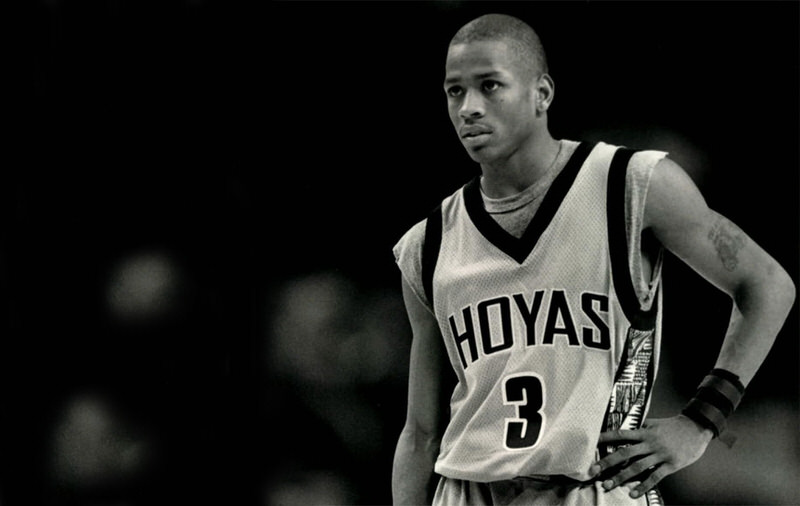
CHAPTER 1 | THE EARLY YEARS
As a standout at Bethel High School in his hometown of Hampton, Virginia, Allen Iverson was immediately a two-sport star in both football and basketball. He very nearly had his life — not just his basketball hobby — but his entire life thrown away after a wrongful conviction stemming from a bowling alley brawl gone wrong.
He served four months of jail time before being granted clemency, and once he returned to basketball thanks to a much debated scholarship at Georgetown University, he was quickly rising the ranks of the nation’s best players. He’d even landed on just the 9th issue’s cover of then-upstart SLAM Magazine.
Not too far up the east coast from DC, two young and hungry Reebok employees in Todd Krinsky and Que Gaskins were taking notice, as Iverson set a new school scoring record of 22.9 points per game. They’d soon pull emerging Reebok designer Scott Hewett in, and together the three hatched the plan to try and pitch Iverson with his own shoe, should he go pro.
Once AI declared for the NBA Draft during the spring of 1996 and decided to leave school after just his sophomore season, the ball was in motion for Reebok to make their greatest athlete signing in company history.
Todd Krinsky, Reebok VP: There was a small group of us here that are basketball junkies, and we just remember watching him get to the tournament his sophomore year, and he was just exciting to watch. His speed was just insane. He was little, but he had hops. People don’t remember, but he was dunking on guys in college. Even back then, before the transformation with the tats and cornrows, he still had a swagger about him, that confidence and he was a good looking kid. He definitely separated himself that year from a lot of other players in college. He was everything you look for in our business. We were looking at it from two lenses. We were fans of basketball, but then we were also looking to sign someone, and he definitely was someone that’d be great for our business.
Gary Moore, Allen’s youth mentor and longtime Manager: To be offered a scholarship at one of the most prestigious universities of its kind in the country and to play for a legendary coach in John Thompson, it was a blessing. I know that he’s thankful every day, because I’m thankful every day.
Dennis Page, founder & publisher of SLAM Magazine: I was a huge Steph [Marbury] fan and a huge Iverson fan in college, and there was no dispute with Iverson, but I was reluctant to have a college player on the cover. It was a really poor seller, so I was very reluctant to do a college cover again after that. We split it with [UCLA’s] Charles O’Bannon though, so we had two regional covers, but no one gave a shit about O’Bannon. [laughs]
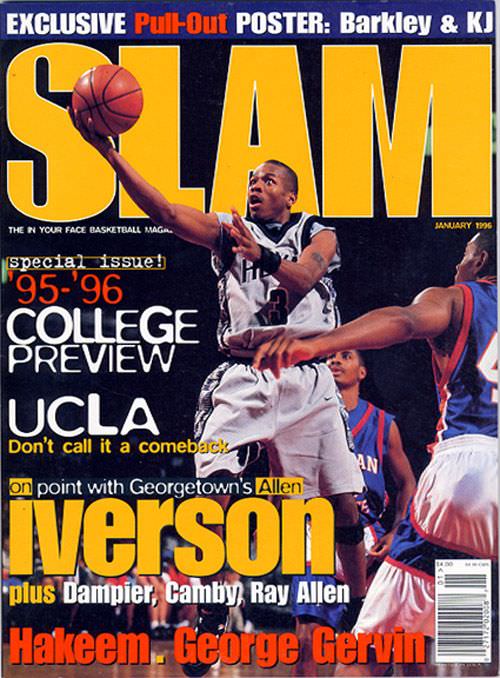
Que Gaskins, Reebok Basketball Business Unit Manager: I was from DC, and I was a huge Georgetown fan. I had somewhat of an inside track into Allen, because my High School coach had become an assistant coach over at Georgetown. John Thompson III was actually one of my high school teammates. Me and John the 3rd were actually high school teammates and classmates. I had a great affinity for Georgetown and was always very aware of their players. When Allen first came in, I was like, “Oh my god, this kid is amazing.”
Dennis Page: In that first interview that we did, my main question was, “Where did you get the crossover from?” I thought it’d be some obscure guy on the playgrounds of Hampton, but it was a teammate of his that barely played at Georgetown, Dean Berry. He was really cool about that, and I was afraid I’d offend him, as I usually do to people, by asking that. But he was like, “Nah, nah, that’s cool. It was Dean Berry actually. He showed me how he did it, and then I just tried to do it a little better.” That was so cool how humble he was about it and giving the right credit. Not everyone would do that.
Que Gaskins: I’ll never forget this game, it was against UMASS. Allen was coming down, and he had drifted across half court. He was coming towards the left, he crossed the ball to the right coming towards the center, took a couple dribbles and just came right down the middle and banged on Marcus Camby. I just remember saying to myself, “Oh my god, we gotta get this kid! That’s the one!” Todd had the same epiphany. He was watching the game too, and said the same thing to himself.
Todd Krinsky: The next day, we saw eachother, and Que was like, “Yo!” And I was like, “Yo!!” It was an extensively intelligent conversation. [laughs]
Que Gaskins: Todd, Scott and I all were at the office after that and got together, and we started talking about trying to get Allen and what it would take. We started embarking on this path to try and convince people at Reebok that we should go after him. In the beginning, almost everyone inside the company was against it, and no one thought it was a good idea. Allen was playing at Georgetown, which is a top Nike school, and John Thompson was on the Board of Directors with Nike. He played at Bethel, which was a Nike High School, and he went to all the Nike camps. There were rumors that Nike was flying him around to go to these camps, and everyone thought it was ridiculous that we’d even think we had a shot at a kid like that.
Todd Krinsky: At that point, he had arrived, and we felt right then that he was what we needed. That play on Camby, he had arrived on the national landscape in the NCAA tournament. We had already been talking about him, but that was the moment where we went, “Yeah. He’s the guy.” Before that, he had the swagger and we knew he was a great player, and he was exciting and had no fear, but that next day, we moved the conversation from 20 miles an hour to 80 miles an hour. Right after that, we started to develop the Question.
Que Gaskins: We started working on the project before Allen even committed to turn pro. We were young, we were risktakers and I like to think somewhat visionary. [laughs] We felt like, “Here’s a kid that might come out, and if he comes out, we want to be ready. We want to show him that we’re serious.” There were just so many fucking questions around him as a player, around his character and around whether or not Reebok could even afford and be in the running for a player of that stature, so we called it The Question.
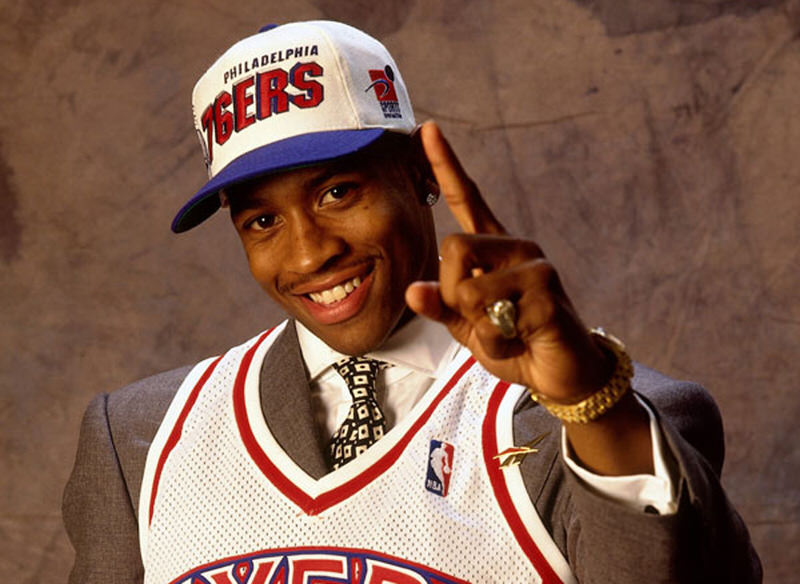
CHAPTER 2 | THE SHOE DEAL
By the time Allen Iverson was selected with the 1st overall pick in the 1996 NBA Draft — a draft that’s routinely referred to as one of the top 3 deepest drafts in league history — AI not only donned his already-made Sixers rookie jersey over his suit, but he also slyly affixed a gold Reebok logo pin that was visible in every press photo.
While Iverson was clearly beaming as his name was expectedly called first by David Stern on that June 26th night in East Rutherford, it was his landmark endorsement deal with Reebok that was hardly a given that spring.
As a company, Reebok had been going through a down period, to put it lightly. A decade earlier, during the height of the fitness boom in 1987, Reebok was enjoying a 30% share of the athletic footwear market, notably ahead of Nike’s 18% share. That was of course the year that a young designer at the Swoosh named Tinker Hatfield created the Air Max 1, Air Trainer 1 and Air Jordan III all in sequence, changing the fortunes at Nike for good. The innovation and advanced designs coming out of Beaverton, Oregon also severely hurt Reebok, as they looked to catch up on the product side in not one, but three categories. By 1996, Nike had a 43% market share in footwear, while Reebok’s had dwindled to just 16%.
With Shaquille O’Neal, Shawn Kemp, Glenn Robinson and Nick Van Exel in the fold, Reebok’s pro backcourt was severely lacking, and in the eyes of two recently hired twenty-somethings in Todd Krinsky and Que Gaskins, the league’s top rookie Allen Iverson was — yes — clearly the answer that the brand needed.
***
Todd Krinsky: Que and I were younger, and the consensus for most of the older and senior people at Reebok was, “Yes, we like him, but won’t there just be another Allen Iverson?” That’s when Que and I looked at eachother, and then looked at the audience and said, “No! That’s the point. Didn’t you see the Camby dunk?”
Que Gaskins: There were a couple things that were in our favor. One was – and a lot of people didn’t see it this way, initially – but when Allen decided he was going to come out, he picked David Falk as his agent. Anybody who graduated from Georgetown, so Alonzo, Dikembe, Patrick Ewing and even the coach, John Thompson, they all were represented by David Falk. Everyone definitely felt at that time that he was definitely going to Nike. There was no ifs, ands or buts about it to some people at Reebok. But with David being a smart businessman, he understood that he should talk to anyone that was interested in Allen. It would drive up Allen’s value. You just don’t want to have one brand showing interest, you want to have all of the brands showing interest. The fact that Reebok was showing interest, if nothing else, it would give him more leverage with Nike.
David Falk, Allen Iverson’s first agent: He had been with Nike, both in High School and in college at Georgetown, but we took him around to different companies, and Reebok was really in need of a superstar. I told them that if they wanted to have serious discussions with Allen, that he wanted his own shoe and aggressive promotion. They were very enthusiastic about that.
Todd Krinsky: When you’ve got a young guy that’s a little smaller and plays off the dribble, that has an exciting game and can dunk in traffic – when you have all of those things, plus you’re a good looking kid and you’ve got a swagger and an urban profile – if you have three of those attributes, you’re good. If you have all of them, it’s like lightning in a bottle. Que and I were really, really pushing some of the older guys, but that’s one of the things about Reebok that’s so great. Young people have always had a voice at this place. There’s an entrepreneurial spirit, and [Reebok CEO] Paul Fireman went, “Ok, you know what, lets do it!”
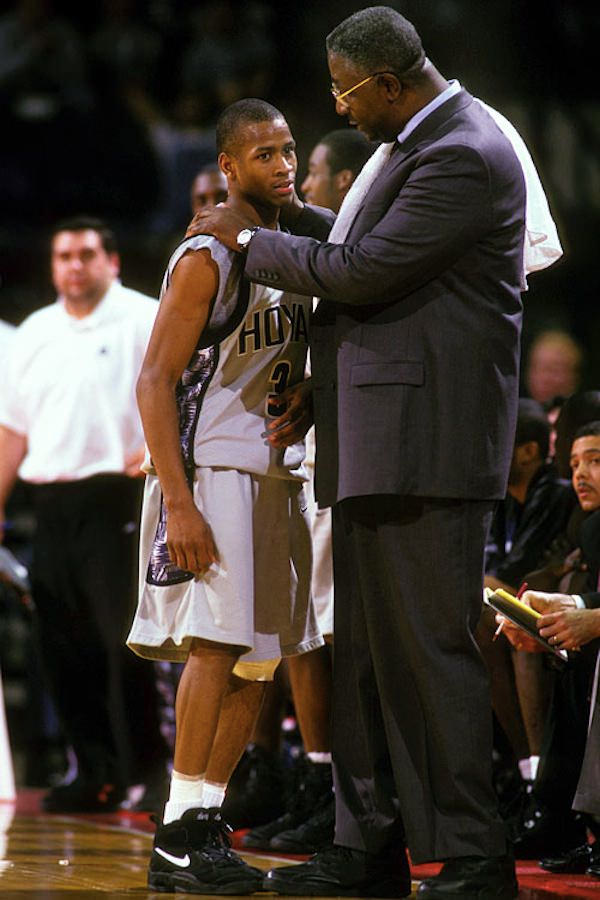
Allen Iverson: I remember when I went to Coach Thompson, and I told him it was between Reebok and Nike. He was on the Board of Directors at Nike. [laughs]
David Falk: Typically, I call all of the companies and give them an opportunity to make a presentation. It came down to Nike and Reebok, and obviously Coach Thompson is a strong Nike guy, and Georgetown is one of the top Nike schools. John’s on the Board at Nike, and has a close relationship with Phil Knight. [laughs] In that year though, in 1996, they weren’t nearly as aggressive. They wanted to have Allen, but they weren’t prepared to step up to the level that it was going to take to sign him.
Que Gaskins: I think David looked at it like, if he could have a star player like Jordan over at Nike, and now he’s got this brand Reebok that wants to come up on the rise and compete, if he can get a star player over here too, it’d be better for him. He would have the keys to the kingdom.
Todd Krinsky: David had some connections to Nike, obviously, but I think he was trying to run this one pretty fair. Allen always had an ambition to do things different too, and I think that he wanted to be his own guy. He wanted to be with a brand that was going to emphasize him, build him up and spend money and time with him. He wasn’t going to be behind five other players, like he would’ve been maybe at Nike. I think it was the kind of irreverence and risk taking that Allen was open to, but I think that David also pushed the deal. Any agent knows that it’s good to have players with different brands and diversify your own portfolio. David is smart, and I think he knew that maybe it would be right for him, to have a superstar at Reebok now. For everybody, it just felt right. Allen saw the level of attention and service he was going to get from us, and he saw where the brand was going.
Allen Iverson: I told Coach Thompson what Reebok was offering me and what Nike was offering me, and he told me it was a no brainer. [laughs] He said, “Well, you should sign with Reebok.”
David Falk: The deal was $60 Million, for 10 years. It was the highest guarantee that anyone had ever gotten in shoes.
Todd Krinsky: There wasn’t really any risk to us. Clearly, he had the [bowling alley] issue down in VA, but at that point, he was with John Thompson for a few years and going to Georgetown.
Dave Fogelson, Reebok PR Director, via 1996 statement: If we had hesitated, somebody else would have grabbed Allen. That’s the way this business works. We looked at it this way: With the coaching Allen received from John Thompson and the Georgetown program, and with David Falk as his representative, we felt there were strong people surrounding him.
David Falk: A lot of people criticize the connections that I enjoy with Georgetown, and obviously Coach Thompson is very close with Allen. It was like having an extra pair of eyes for the player. He kept a very close eye on what you’re doing, what you ought to be doing and what you shouldn’t be doing. I think that was really helpful.
Allen Iverson: It wasn’t just because of the money, it was because of the loyalty and the way that people treated me.
Gary Moore: It was just like family. It started in a family type environment. Todd Krinsky was there from the beginning and Paul Fireman was the chairman. It was just a tremendous team of people at Reebok.
David Falk: I felt my job as a brand manager for my clients was to understand what would work best, and not necessarily who would pay the most money. Over time, if you were establishing a signature shoe, you would make the most money from royalties anyway. Honestly, I had a very, very close relationship with Nike. From 1986 and on, the vast majority of our clients were with Nike, but there were situations where a younger company made more sense. When Michael signed with Nike in 1984, they were the #3 company. They were behind Converse and adidas, and over time [as Nike got stronger], companies that were coming into the market were looking to be very aggressive. At the time, Nike had Michael, Penny, Barkley and a bunch of people, and it wasn’t that we didn’t think Nike could do a good job, but they didn’t recruit Allen as aggressively. They said they could do certain things for him, but Reebok was so much more aggressive.
Allen Iverson: All along, Reebok told me they didn’t want to make me up. They didn’t want it to turn out to be something that I’m not. They wanted to let me be myself. They were just going to let me be, whatever that is.
Que Gaskins: David Falk also took a page out of the Jordan book. When Jordan signed his deal with Nike and with the success he had with that deal, there was one person that Jordan had to connect with and everything would go through. That was Howard White at Nike, on Jordan’s behalf. So Falk said, “Who’s going to be that person over at Reebok?” He didn’t say who’s going to be his Howard White, but that’s basically what he was saying: “Who’s going to be Allen’s Howard White?” I’ll never forget my boss saying, “Well, it’s going to be Que.” Of course, I signed up for it, and I ended up moving to Philly.
Todd Krinsky: [Once we signed him,] it was kind of surreal for us, because a bunch of us had been championing Allen in our corporate offices for a long time. Myself and Que were internally trying to get everyone to know who he was for so long, to get everyone in the mindset that, “There’s a draft every year, but not an Allen Iverson every year.”
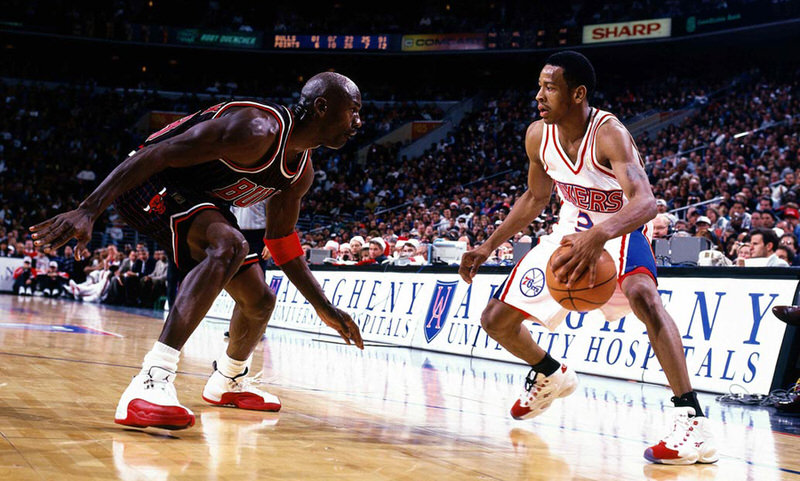
CHAPTER 3 | THE QUESTION
When Allen Iverson was officially introduced as a member of the Philadelphia 76ers, he was only 21 years-old, and yet, his confidence to take on the league and anyone in his way never wavered. “I want to be remembered as the best player in the NBA,” he flatly said when asked about his goals. “That’s a big statement, but I’m willing to try and back it up. I want to be the greatest basketball player.”
He was 21, and yeah, that was a big statement, but that’s the fearlessness that made his game, at his size, so successful. It was also the kind of fight and toughness that made Todd Krinsky and Que Gaskins such huge believers in his ability from Day 1 in the league.
Unlike most players at that time, Allen had his own signature shoe ready for opening night of his rookie year. It was an advantage in their offer over Nike that Reebok strongly believed in all along. As I found out through a source who was then-entrenched in Nike Basketball during the 1990s, Nike was also indeed planning to offer Allen his own shoe.
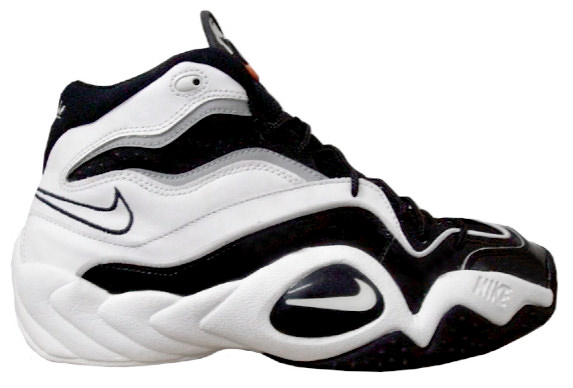
Iverson’s first Nike signature shoe would’ve been the Air Flight Turbulence, only it would’ve been called the Air Bubba Chuck, a nod to his childhood nickname. “That’s why those had the black patent leather toe,” reveals the source. “Like the XIs he wore at Georgetown.”
The shoe would go on to be worn by Gary Payton, Damon Stoudamire and point guards around the league. Meanwhile, Iverson’s debut Reebok Question was, much like Krinsky had predicted his influence and on-court play to be, “lightning in a bottle.”
***
Que Gaskins: With Allen, we played up in our presentation that if you go to Nike, you’ll be one of many, but if you come here, you’ll be the man. You can go over there and wait for them to decide whether or not they’re going to market you, kind of like how they did with Kyrie now. Here’s a kid in Kyrie that doesn’t get his own shoe until in his fourth season. With Allen, we thought the soonest, at the very, very soonest, that Nike would’ve given him a shoe was by the All-Star break, because you need time to develop it. One of the things we heard from the research we did, was that he was definitely interested in having his own shoe from Day 1.
Todd Krinsky: The first time we met him in DC was more about just getting to know each other. We didn’t show him the shoe the first time, but we did the second time. His eyes lit up when he saw the shoe. I think he was really impressed that we were working hard and I think he really believed in us. He saw the passion that this wasn’t just another project for us and he just really liked the shoe. He made some comments on things he liked and didn’t like, so we made some small changes before we released it. A lot of us were new to the game, so it was new to us too to be able to work with someone like Allen. He definitely appreciated it from the beginning.
Que Gaskins: We had the shoe developed before we even met with Allen. We had been working on it, and we were gung ho that even if he didn’t sign with us, it was still the type of basketball shoe that we would want to make and bring out to the market. That’s why we called it The Question too, because it could’ve ended up being its own shoe. We would’ve had a Plan B and put it on someone like Kenny Anderson or Nick Van Exel, and we could’ve easily made it a lead guard shoe and built a guard story around it. We really weren’t thinking too much about a Plan B though, and we put all of our eggs in one basket with Allen.
Allen Iverson: I remember Todd showing me the shoe – and it didn’t really matter what it looked like. [laughs] You know what I mean? It didn’t even matter. Just the fact of it being my shoe was enough for me. It could’ve been anything. They probably could’ve came in with a flip flop with my name on it,[laughs] and it would’ve been cool with me. Then, seeing the shoe made it that much better. I liked the shoe off top.
I was just talking to my teammates at Georgetown, and they’re all asking me, “Man, do you think you’re going to have your own shoe?” I’m like, “I don’t know!” Hopefully something like that would happen for me, but it was so far fetched, and it was like I didn’t think that would actually come true, where I’d have my own sneaker. I just remember being so excited and calling everybody, like “I got my own shoe! This what it look like.” I remember taking pictures of it and just showing everybody the shoe. It was just an incredible feeling.
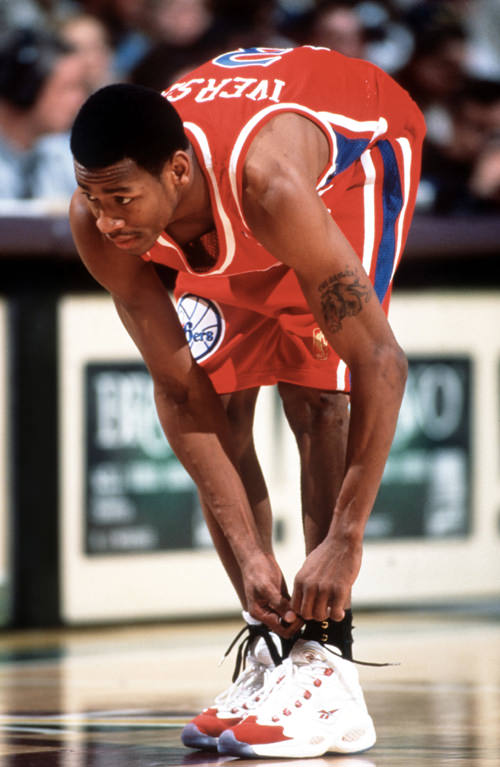
Gary Moore: Having his own shoe was a huge factor, because it was unheard of, as far as we were concerned. Sure, Michael Jordan had his own shoe, but from where we were from, we really didn’t know of anyone that had their own shoe. That was a huge, huge part of the decision that Allen made to go with Reebok. He was just so elated to have his own shoe. That meant so much to so many people.
Brandon Richard, longtime sneaker collector and Hampton, VA native: Here, Iverson’s Reebok signature line was just as, if not more, popular than Air Jordans. In fact, one could argue that the mid-to-late 90s was the peak of the Air Jordan line, but Questions and the first few Answers were spotted on-foot more frequently. It was surreal to see a local kid, who was so attached to the community, have his own shoe. Owning AI’s Reeboks was like a sign of solidarity for the one guy that was out there really doing it for us.
Todd Krinsky: When we designed it, it was really all about performance. We wanted it to be about speed, and we wanted it to have elements of speed to it. We created the speed ghilly lacing system and the pop on the toe because Allen moves so quick that we wanted something to really pop when he’s moving. It was all really created out of trying to make a great product for a speed player, but it had great fashionability. Allen had great style on the court and it looked cool with jeans, especially all the toe colors. We didn’t anticipate it to be a big fashion play, but it quickly became adopted on the street as one of those must-have looks for kids.
Que Gaskins: From a retail standpoint, no one really believed in the shoe in the beginning. When we were going around and pitching it to Athlete’s Foot and the Foot Lockers of the world, they all thought we were crazy. A lot of people don’t typically get out of their comfort zone. I think a lot of people looked at it like, “Allen had always been a Nike kid, why would he ever decide to go with a brand like Reebok?” When we tried to pull the shoe out and show it to those guys, being that we worked in the futures business and had to sell stuff in so far ahead, he hadn’t yet even signed with us. Here we were trying to sell a shoe in. We’re going, “We want you to have the vision that we have, and take the leap of faith that we’re taking. This is going to be his shoe.” They’re all looking at us like we’re crazy. They’re going, “Listen, don’t waste our time with that, put it back in the bag and lets talk about the real Reebok business that we’re capable of doing.”
Todd Krinsky: Even though we started designing the shoe when AI was still at Georgetown, by the time we confirmed the shoe and signed him, we could only get limited pairs into the marketplace that fall. We figured we’d use that to our advantage, so we only put them in certain areas. We put them in Philly, New York and DC and that was really it. When we first put them out, I started getting phone calls in the morning that kids were coming in right after school and that the shoes were almost sold out, and that was only one day. We started hearing stories from the store employees that kids were coming from Delaware and Boston, driving 3-4 hours to go to the Philly store to get the shoe. After the second day, it was completely sold out.
Que Gaskins: We were only able to manufacture a limited amount, and not as many as you would ideally do for a guy like Allen. They sold out instantly, and you had people driving up from all different places and calling from LA and all across the country trying to get their hands on them. By that time, they had been validated by Allen being the first pick and him signing with Reebok.
Todd Krinsky: When we put out the first 5,000 pairs of the Question, kids were driving up from Virginia and from DC to go to Philly to go get the shoe. We could only put out so many cause we were going so fast. It was within the first couple weeks of his rookie season, and I remember calling Allen like, “Yo, they’re all gone.” He went, “Huh?” I was like, “This is one of the first times this has happened with a rookie, but they’re gone.” That’s when I really realized that we were on to something special.
Allen Iverson: The guys that came in with me and the guys that were my age, they all thought it was cool that I had my own shoe. A lot of guys had contracts with different shoe companies, but they didn’t have their own signature shoe, so I’d kinda puff my chest out a little bit. [laughs]
Dennis Page: Reebok had some success, maybe not selling shoes to the level of the other brands, but they had credibility with Shaq, Shawn Kemp and Van Exel, before Iverson came along. You can wonder, did Iverson make the shoe, or does Reebok get the credit? It was just a perfect storm. Maybe even if Fila did that shoe, it’d be what it was, because of who Allen was. Those guys were just so powerful. If you have the right player that resonates, it can be easy, and it was a dope shoe. It was definitely – revolutionary might be too strong – but it was definitely a great different look from what was out there. They nailed it.
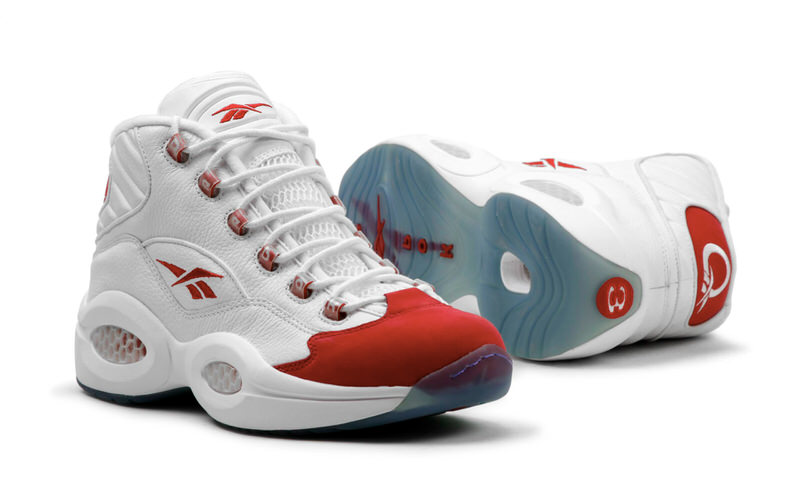
Todd Krinsky: It’s funny. If you look back at the sell-through of the shoe, it’s one of the only shoes that sold equally well in both the suburbs and urban areas. Some of the markets that sold suburbia wise were really shocking to us, but then, every borough in New York and in Philly it did really well, too. The shoe itself was really clean and wearable, and also Allen transcended all barriers. Kids all over the world loved him because of his heart, his fearless play, and his size. He was a little man competing with these giants night in and night out. Those attributes are universal. You don’t have to be from the hood or from the suburbs to respect a kid that’s 6’1”, 165 pounds giving it his all every night. That’s just universal. I think Allen himself meant all sorts of things to different people for different reasons and the shoe itself was clean and really wearable. A combination of things made it so relevant around the world and in different pockets of the world.
Gary Moore: First impressions are the most lasting impressions, and that first shoe, the Question, will have a lasting impression.
Allen Iverson: Shit, honestly, just putting them on for the first time and stepping on the court, knowing that I had my own shoe, was the best. I was a shoe fanatic and always dreamed of playing on the professional level. To then add icing to the cake and be able to have your own signature shoe, you know what I mean, it meant something. These are mine. Knowing that people that rolled with me and that were my fans will support me and rock my joints was my best moment. Just putting them on, man, I would always look forward to having them on and walking out there. Having different styles and different colors – I know I drove Todd [Krinsky] crazy wanting a different color almost every game. [laughs] Just having my own shoe was a dream and a blessing. Definitely.
Todd Krinsky: In the beginning, he always would say, “If I don’t look good, I ain’t playing good.” It was just a mental thing. That’s why we had so many colorways over the years. Even when he knew I couldn’t do it, he would call me on like a Wednesday and have a game in Milwaukee on Friday. He’d go, “Yo, I want to wear White / Silver on Friday.” I’m like, “Chuck, we’ve been through this a million times. You know the calendar as well as I do. I can’t give you a new shoe in 48 hours and have it be in Milwaukee for you.” [laughs] He’d really think about these colorways in his mind, it would just happen to be a day before the game that he wanted them.
Allen Iverson: The first kid I even seen with ’em on, I was in my car. I remember stopping in the car, and I was looking in my rearview, and I watched him until he walked out of sight. This was the first time I seen somebody besides my family or my friends with them on. My whole world stopped. I just sat and watched him until he walked out of sight, and I remember driving off like, “Damn.” That was the first person that I saw with my sneakers on, and it was a little young kid. It’s just something that I’ll cherish for the rest of my life, and it’s something that I’ll never forget.
Todd Krinsky: Retailers were calling now, saying, “We need more! We need more!” [laughs] Really quickly, the senior guys at the brand knew what that meant, and they’re looking at the pairs selling and saying, “Ok, lets sell more!” For Que and I, we were looking at it more from a cultural perspective. We knew it was really cool and was putting Reebok in a different place. We had some relevance now with young kids, and Allen has arrived.
John Borders, Reebok VP, via Fall 1996 statement: Allen Iverson has already paid for his investment. He’s already earned every dime we’ve given him. We’re a struggling company. We didn’t connect with a young audience. That’s where Allen helped us. We all wanted to listen to him and see what he thought about himself. We wanted to know what his connection would be to that consumer base. He’s helped us focus a campaign.
Todd Krinsky: People always ask why the Question was so successful, and I always say that a lot of elements need to happen for a signature shoe to work. The player has to perform at a certain level and have a certain style, the shoe has to be right, and he has to have a great season. That’s what happened with the Question: Rookie of the Year, the crossover on Mike, the shoe, everything.
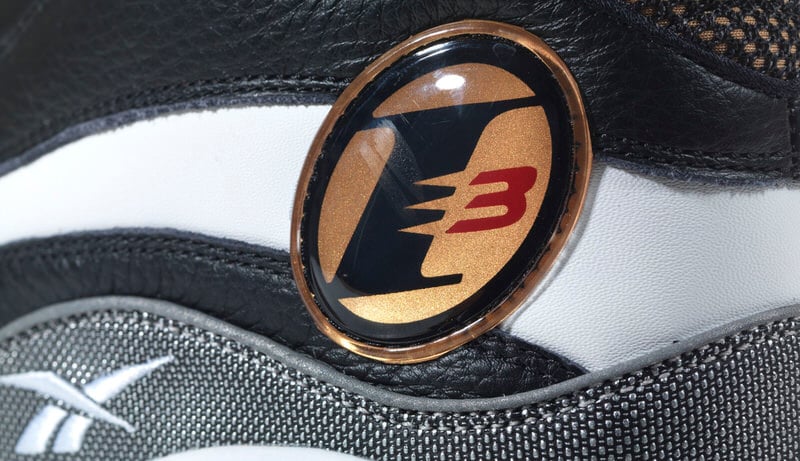
CHAPTER 4 | THE ANSWER & I3 BRAND
As we’ve often seen over the years in the signature footwear business, following up a hit can be a challenge. There’s certainly a batch of sophomore slump sigs that’ve released over time, but The Answer surely isn’t one of them.
Despite the massive success of The Question, and with more corporate eyes and retailer involvement this time around, the second Iverson shoe delivered, ushering in Reebok’s DMX cushioning into hoops, a sleekened look and the “I3” logo that would become a hallmark of the Iverson brand.
While The Question was mostly designed and developed without a true feedback timeline for Reebok to get Allen’s input on the product, The Answer was afforded a full product cycle, and time for AI to share the direction and design he wanted to see going forward.
***
Todd Krinsky: You always go through these types of conversations in the company, where you say, “Ok, what’s the overall design and DNA for the athlete?” For the Question, it was kind of this in your face, toe-driven and fast look with the big Hexalite, or as kids would call it, the honey comb. It had a great cushioning story, but Hexalite wasn’t the big story going forward for the brand. We had DMX now, and a lot of players would say, “It’s like walking on clouds.”
We felt like it would be a good technology for AI, because of his quickness moving North-South and his quickness moving side to side. We all felt like that cushioning technology would be really good for him. We decided to move him in that direction and put him in that product. At that time, we also created the I3 logo, which we didn’t have ready for the first shoe. The first shoe was something that we were creating off the cuff, with not a lot of tools. It was a pure design.
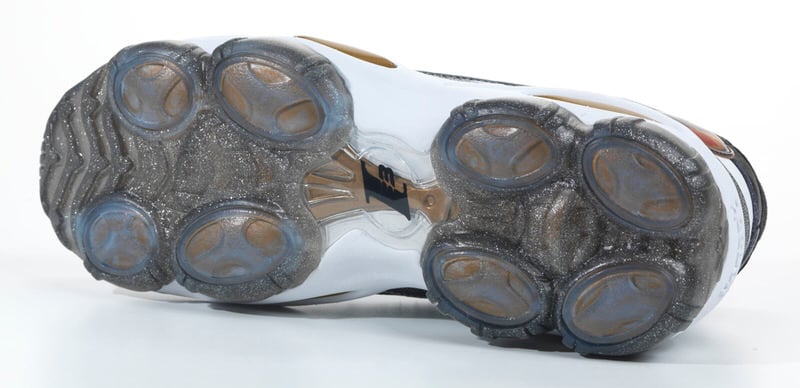
Que Gaskins: We created a brand direction for him, and we wanted his I3 brand to have what we called the SCI factor. That stood for Speed, Creativity and Innovation. At that moment in time, Nike was the biggest dog in the game, and they were a performance brand that was using lifestyle and entertainment to make themselves authentic and cool. Reebok was much more of a lifestyle brand that was trying to use performance and technology to authenticate and validate who we were. The lifestyle piece came natural to us, and we loved Allen because we knew he had that connection.
When you think about the Crossover ad that we did, or the New Move ad, we tried to show how the DMX technology and some of the stuff that we were putting in the shoes was ultimately helping him to become a better basketball player and performance icon. We knew that Allen would do the lifestyle piece in his sleep, so we didn’t have to spend any money marketing that. Lets not waste time marketing that initially. Lets try and show these kids that are sold on Nike, that we can be a performance brand too.
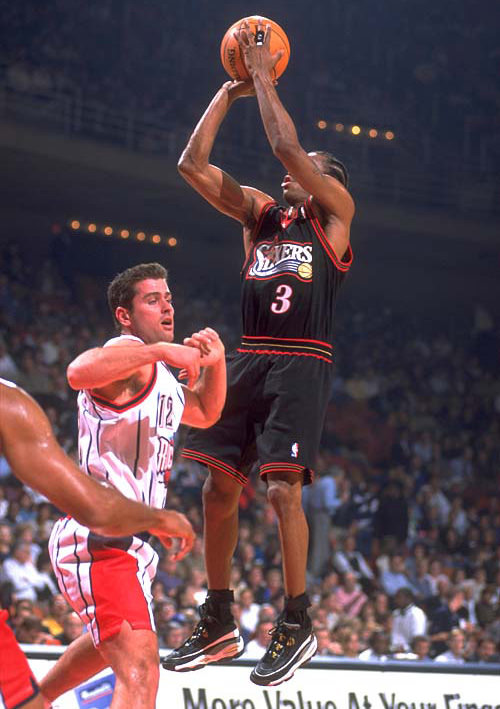
Todd Krinsky: For the second shoe, we introduced DMX, he had his own logo, and we tried to create a really unique look down the throat, where you could read “Iverson.” You could play in it half open. We wanted to also have a fast line that went around it. It was definitely a departure from the first shoe and the design was different. The second thing was now you’re getting into how many pairs we’re going to make, and what is the supply versus the demand?
For me, there was a sense of purity and serenity with the first shoe. It was me, Que and Scott in Scott’s living room in Quincy, Massachusetts. It was three kids playing the “What If?” game. When it got to The Answer, there was a lot of people involved, and it was a real business. Sometimes the simpler things in life are better. The Answer is definitely a cool shoe, and it had DMX and was a cool look, but it was a big departure from the Question.
David Falk: I worked very, very closely with the people at Reebok, and I like to get involved in those things. I came up with the tagline, “The Answer Is Clear,” and we made the bottom of the shoe clear. That was a play off of his nickname and you could see through the sole.
Que Gaskins: If Jordan represents Air, then Allen represents Speed and everything that happens below the rim. Jordan was my guy growing up, and when I was playing, you wasn’t a real ballplayer unless you could dunk. Everyone was trying to work on their hops. When Allen came around, he took the game below the rim. He invited a whole group of people into the game who had handles and speed, and the game became something different. If you could just hit a guy with a crazy move, it could look crazy and you didn’t even have to score and you’d get cool points! [laughs]
If I could get the crowd to go “Oooooh!!”, you didn’t even have to finish. It was a completely different phenomenon. He had the Speed and Creativity part down, and then Innovation came not only with how he dressed and the Dress Code later on, but also with the rules of the game. They changed the hand check rules, what was and wasn’t considered a carry, and there were a lot of things that he influenced performance and lifestyle wise on the actual game of basketball.
Todd Krinsky: He wanted the designs to be synonymous with speed. He was always talking about designs that’d be fast and that’d look like they were moving on paper. He wanted shoes that could take material and color in really different ways, because he got so bored, so easy. To have him wear one model for the whole season, you had to really spin a lot of colors. If you look at the year he went to the Finals and won MVP, we had a ton of versions of that shoe for him. He just fundamentally would get bored so quick.
I3 was synonymous with speed, so he wanted very fast designs. He liked for shoes to be lightweight, but he also wanted a lot of support. The crossover became a signature move, but the crossover really set up everything he did. Him off the dribble was always about that lateral push. Even though he wanted the shoes light, he was willing to compromise a little because he wanted a lot of support too. He was just going so fast east to west, so it was a lot about lateral stability. He was super into the aesthetic and the function.
David Falk: If you look at Allen, pound for pound, he’s one of the great performers in the history of the league. More than his performance, because there’s been a lot of great players, he just has a very iconic stature in the league. He was the first real hip-hop star in the league. He had his own street cred, as people tell me [laughs], which is critical in establishing a brand. He did things his own way. He was also a two-sport athlete. He was a great athlete. He was one of the best football players ever in Virginia, as a quarterback. He maybe could’ve been Michael Vick. He was fearless.
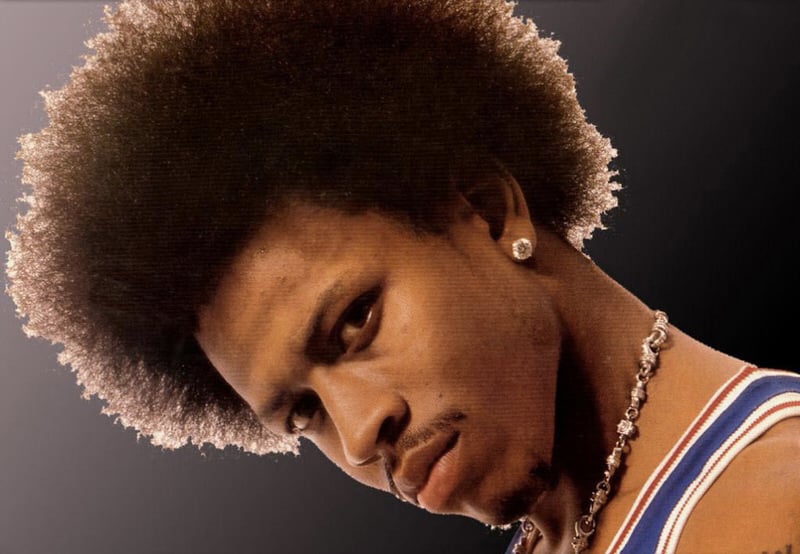
CHAPTER 5 | MARKETING THE REAL ALLEN
When Allen was reaching the apex of his influence, you started to hear marketing buzzwords like “authentic,” “true,” and the always-awkward-in-a-corporate-meeting “keeping it real” from competing brands in the urban landscape.
Allen really was all of those things though.
As Reebok executives would realize, letting him just be himself, and taking both the good and the bad that comes with it, proved to be the best plan of attack in framing his marketing.
The people that already hated him weren’t going to be swayed any time soon — and the people that loved him? Well, to them, Allen Iverson became a heroic new age icon the marketing world hadn’t yet seen before.
***
Todd Krinsky: Reebok as a brand, we needed to have an irreverent approach to sports. We weren’t going to just run the ball down the middle from a marketing perspective and be simple and a regular performance brand. That wasn’t going to work for us, and that’s not how the brand started. That’s not who we were through the years, when we had Shaq and doing things like Planet Reebok, it was always a little bit of an irreverent approach to sports. When we signed Allen, and the more we were around him, we realized that this was one of the more unique guys that you’re ever going to meet. We weren’t creating messaging with him, but really allowing his personality to come through, which is something he really wanted to do.
Allen Iverson: It’s the best. I mean, Reebok let me do me. Everybody, when I came into the League, was afraid of me being me; afraid of me just being like the dudes I grew up with. I didn’t come up with the styles. A lot of styles I bit off dudes that I hang with. I didn’t want to be somebody else because I was in the League. I wanted to be myself.
I thought it was cool and I wanted to be the person that my mom looked at and said, “That’s my baby.” For my homeboys and people that I grew up with and went to school with, you know, I didn’t want to change who I was because of where I was at. Reebok let me be myself; they invested in me and marketed me like I wanted to be marketed. That’s why I’m loyal to them and I’ll always be there with Reebok, and it’s real.
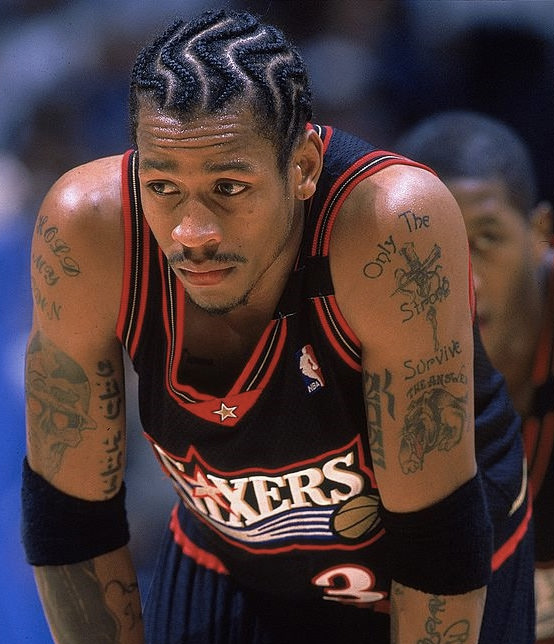
Todd Krinsky: He didn’t want to hold up a shoe and say, “This is my shoe.” Over the years, he didn’t have a lot of endorsement deals, because he’s not a pitch guy. He’s a real guy. We wanted to make sure that what we were doing really fit him, or it wasn’t going to work.
Que Gaskins: I often think that if we would’ve had Twitter, Instagram, Snapchat, Facebook and all that stuff at the height or at any point of Allen’s run, he possibly could’ve become the most culturally dominant player ever. Just because he had the charisma and authenticity that people were starving for. With Eastbay, SLAM, and also music videos, that was our marketing. We played a lot in music and entertainment culture, as a way to help market the brand. We were trying both traditional and non-traditional methods in terms of trying to connect with the young consumer. We looked at the 12-18 young urban male as the sweet spot for what we were doing around the I3 brand.
Dennis Page: In ’94, ’95 and ’96, that was the heyday of hip hop culture, and you had guys like Iverson, Steph [Marbury] and [Kevin] Garnett that were so much apart of what basketball culture was at that time. I was publishing XXL at the same time too, and guys were dressing a certain way and it was a total perfect storm for SLAM, the NBA, college and it was the epitome of these types of players.
Gary Moore: Reebok wanted to do everything that they could to help him to grow and to help mature, both professionally and personally. One thing that family does, is family stands by family. Reebok clearly stood by Allen every step of the way, and we couldn’t ask for a better professional association with an organization.
David Falk: If you look at different people who’ve endorsed shoes, I think Allen has a great spot and a tremendous level of popularity, even today. He was in his own way, what Jay Z is trying to do with sports now. He was a crossover guy before anyone else. He just had a very unique appeal. You can’t create that. My criticism of today’s players, is we never tried to create an aura for Michael Jordan or Allen Iverson. They had their own aura. Allen had his own popularity, being who he was. As you know, he was very committed to being real, as the expression was. He didn’t want to change, and he didn’t want to conform, to be someone like Grant Hill, just to use an example. He wanted to be who he envisioned himself to be, and I think he did a great job of that.
Que Gaskins: We spent a lot of time looking at market research, and we spent a lot of time analyzing what really makes an effective sneaker seller. When you really think about what makes someone super successful, like AI or Jordan, you have to have the whole package. You have to work on the court, you have to be someone that people want to be off the court, and you have to be impacting culture in a unique way. You also have to be the kind of person that guys want to look up to and respect – be a man’s man – and then girls adore and want to be with. When you have all of those things working for you, which AI had, it makes for a very interesting formula to be able to sell shoes.
Allen Iverson: Reebok believed in me. They believed in Allen Iverson, trusted Allen Iverson and I think most importantly, they gave Allen Iverson the room to grow. When I got into the league, I was 21 years old. I didn’t know anything about being rich or anything like that. With my talent, everyone wanted me to act like I was 31 years old, but I wasn’t ready for that. Reebok was always with me, through all my ups and my downs of my career. They always stood by me and stayed loyal to me.
Gary Moore: The reason that everything worked so well was because Allen was a cultural icon. He changed the entire culture. He made it ok to be who you are, and be who you wanted to be.
Que Gaskins: He was also approachable and relatable in the sense that he was 6-feet tall or shorter and 165 pounds. He’s like Steph Curry now, and kids can aspire to be that. You couldn’t aspire to be Shaq, 7 feet tall and 300-something pounds. That’s god given talent. You can’t even really aspire to be LeBron James or Michael Jordan. That’s a lot of god given talent. But when you see a guy like AI or a guy like Steph Curry, who are around 6 feet and they’re doing the things they’re doing and don’t look like they’re taking any type of growth hormones [laughs], they become much more relatable. AI had the whole package, and we knew we had something special in the making.
Nick Engvall, sneaker collector and writer: Allen Iverson represented a struggle of finding out how to be a man. For kids, the timing was right. We were trying to figure out the same thing. He was also hip hop, when every other player was conforming to fit the mold of the world, and he had the strength to say, “This is me, take it or leave it.”
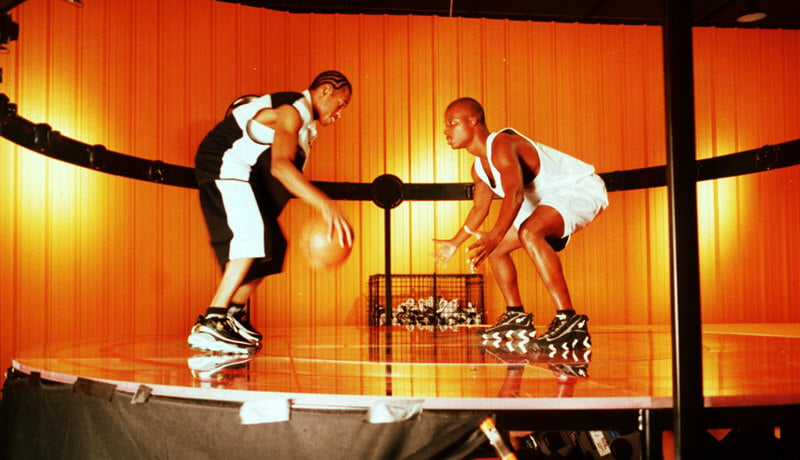
CHAPTER 6 | THE ADS
From the start, Reebok was taking a different approach with not only how their commercials looked, but also where they even showed up. Allen’s first commercial aired during Fox’s “New York Undercover,” one of his favorite TV shows.
It was that kind of attention to detail and extra layering of Iverson’s own style, persona and story that made the Reebok ads so impactful from the jump. AI wasn’t going to be delivering punchlines or telling you about tech specs — that’s not who he was — even though it might’ve worked for other signature guys.
Instead, Reebok crafted ads that depicted his everyday life, whether it was him getting a run in at the park and then heading straight to the club, rapping alongside Jadakiss, or playing pool with his boys. Of course, there was the “New Move” spot, which had me and all my friends trying it out (unsuccessfully) at our middle school courts the very next morning.
At a time in the cultural landscape when corporations were teetering on just how far they wanted to fully adopt hip hop in mainstream advertising and brand communications, Reebok fully supported AI and told his story.
The spots were simply Allen.
***
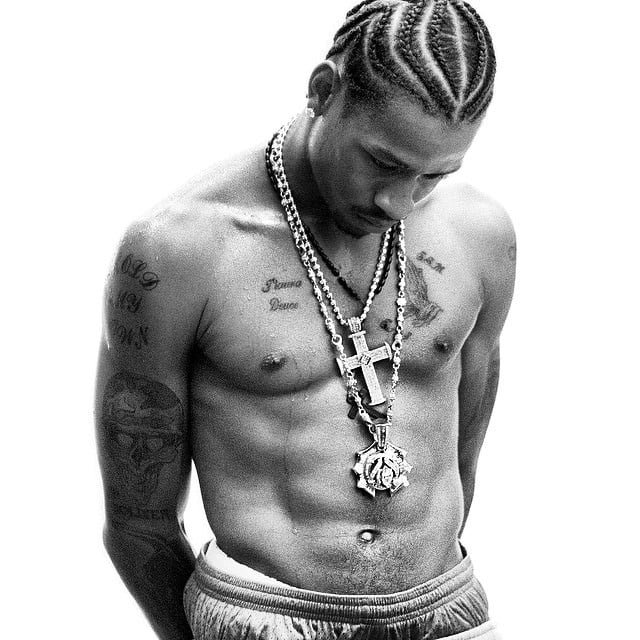
Todd Krinsky: The first ad we ever did, was basically him talking about getting his own shoe. You don’t need to write a script for AI to talk about the first time he saw someone wearing his shoe. He was just talking. Through the years, we always tried to create campaigns that were very real to who he is, that talked about him, his struggle, what he represents and why he’s never changed. If you love me, then love me. If you don’t, then keep it moving. That was a great phrase, that he just said.
Que Gaskins: With us having our ears to the ground and just knowing what was going on in culture, it was a time when urban still wasn’t really accepted corporately in advertising yet. There was always this insight and anecdote where people would say, “Every rapper wants to be a ballplayer, and every ballplayer wants to be a rapper.” That was the understanding in the hood. It was a cultural insight that we decided to leverage in a marketing way, and we didn’t think Nike or another brand could do it. Jordan didn’t really represent hip-hop in a youthful way like AI did.
Todd Krinsky: We brought hip-hop into it obviously, with a few of the Jadakiss ads. If you look at the ads over the years, they would always give you an insight into Allen, and they’d always have an edge to them and there was a hip-hop angle. That was the consistent thread, because it was really who we were as a brand at that point, and it was who he was as a person and as an athlete.
Que Gaskins: AI had a lot to do with that spot. We had started working with Steve Stoute and his agency, and Stoute obviously had a great relationship with Nas. He had tried to convince us initially to have AI and Nas do a spot together. Allen didn’t want to do it, because he didn’t feel like it was authentic to him.
Allen Iverson: If we were going to do it, I wanted to do it with a rapper that I had a real relationship with.
Que Gaskins: He wanted to do it with someone that could really ball, that he’d seen play and had a little bit of game. That’s what Jadakiss represented. That one had the most impact on the culture, and it was a nod to the culture to say, “We understood.” That commercial said, “Ok, somebody over at Reebok is paying attention, and they understand what’s going on.” https://www.youtube.com/embed/rGr3AJfV1rA
Allen Iverson It don’t even have a lot to do with [Jadakiss’] talent. Obviously, he’s talented, but just the type of person he is when we first met. He don’t even call me AI or Allen or anything. He call me by my nickname. We just hit it off from the beginning. Then, his talent is just so overwhelming. Top 5. He’s just the best, to me.
Gary Moore: They had the squeaking of the shoes, and I thought it was incredible. It was the perfect crossover of music and sports, and Jadakiss was phenomenal in his own right. To Allen, Nas was never really in the running, and he wanted Jadakiss all the way. They hit it right off the first time they met, and they’ve always been connected professionally and personally since.
Todd Krinsky: The one in the pool hall in Philly is my favorite, “I Am What I Am.” We didn’t script it at all, and the director was like, “Holy shit, keep going! Keep going! Just let him talk.” He basically was just talking about how he was misunderstood, and how he wants to be a great dad. He was in a pool hall in Philly with his boys, just talking about being misunderstood. It was really beautiful, and it was one of the best things we’d ever done. You’ve gotta love the Jadakiss one too. Jada was great, and they were really close, so it worked really well.
Allen Iverson: That was the genius of Reebok. That’s what made the brand sell. Because it was authentic, it was all original. It wasn’t too much scripted. Everything was freestyle. “This is who he is. This is what he is, and we’re going to market that.” That’s what made it so unique.
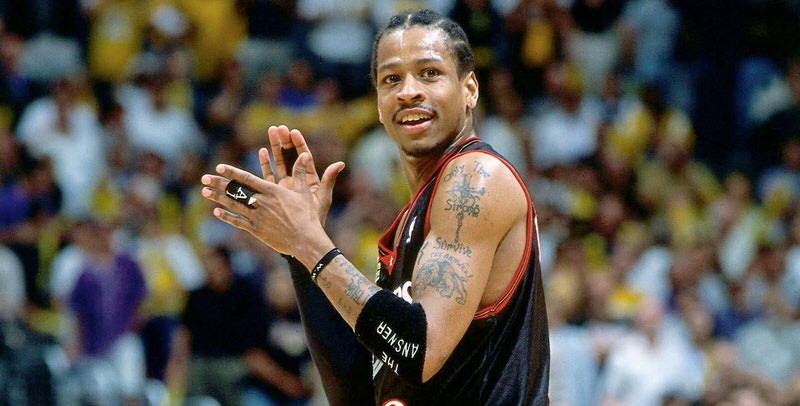
CHAPTER 7 | THE “MAN UP” YEAR
I remember exactly where I was for Game 1 of the 2001 NBA Finals. I was actually playing (off the bench) in a mostly meaningless high school summer league game that night. The reason I’ll never forget it, was all thanks to the brilliant fan in the stands that brought a portable TV that couldn’t have been bigger than a 9″ screen.
Our game tipped just after Game 1’s start time, and by the 2nd quarter of ours, a good 10-15 people had all collected around this mini-TV up in the bleachers. By the 2nd half, not a single person was watching our game. Nearly 50 people were huddled around a portable TV with an absolutely non-HD feed, all to witness one of the greatest single game Finals upsets the association has ever seen.
48 points. 6 assists. 5 rebounds. 5 steals.
Allen Iverson played 52 minutes straight, and single handedly won the game. It was one of the rowdiest crowds I’d ever seen at one of my high school games — they weren’t cheering for us, clearly.
The will to win that AI showcased that night would go on to embody his entire career, and for those closest to him, it was a year unlike any they’ve ever experienced during Allen’s fourteen years in the league.
Just after Game 1, Allen was asked to gauge his level of fatigue from the all-out 52 minute performance.
“I’m not thinking about fatigue,” he deadpanned. “Fatigues are army clothes.”
***
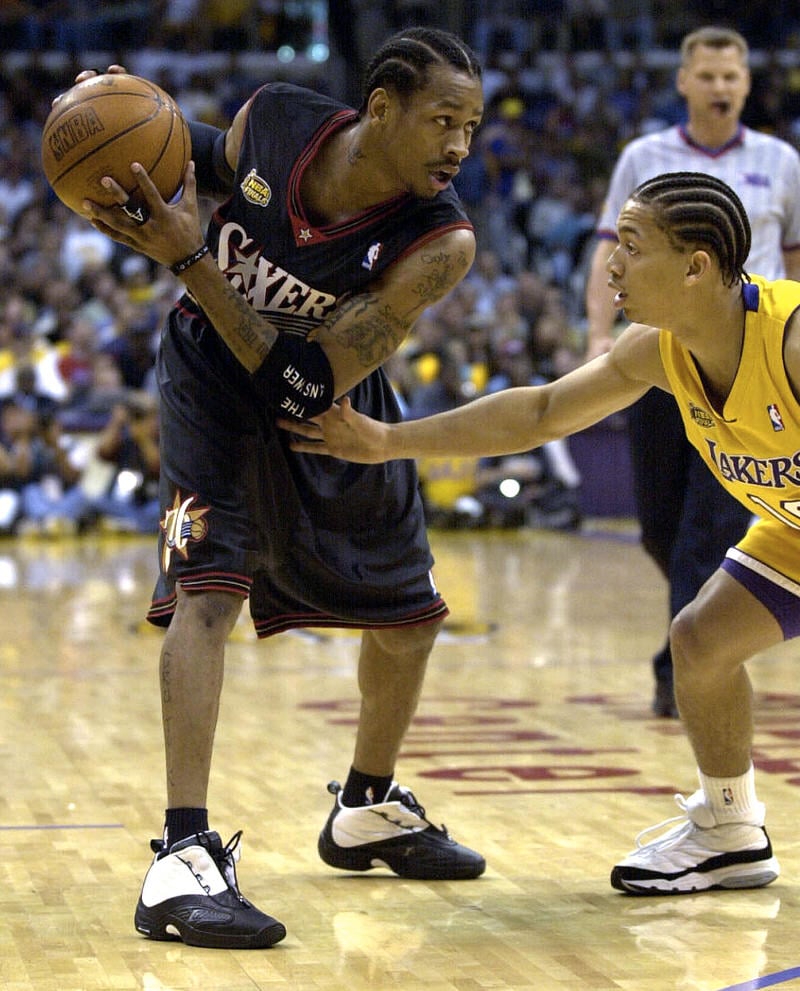
Gary Moore: The summer before that season, Allen was supposed to have been traded. It was at that point that I think the light really turned on for him. He saw just how special he could be, and how his play could affect an entire generation. We went into that 2001 season with so much promise because of that. I was excited, because he came to me and said, “Coach wants me to be Captain! He wants me to be a leader, with Eric Snow and Aaron McKie.” He was so excited, and he welcomed the responsibility of being a captain of the team. He felt like the coach put so much responsibility on him. When that season first started, we won the first 10 games. 10-0, out the gate. I knew that that season was special.
Que Gaskins: That year, he was on the hot seat, and there were rumors that he was going to get traded. I call that his “Man Up” year. That was the year where he really tried to man up and just show everybody that he could be a leader and he was capable of leading a team to the Finals and that he was that dude. He really tried to do things the right way that year. That was a good year. I really wish we could’ve made that year into five years. [laughs]
Allen Iverson: I was getting ready to get traded, that summer before. I didn’t want to be traded. I was so much in love with the city of Philadelphia, my teammates and my fans. My kids were getting it at school. People were coming up to them all the time, saying, “Your daddy is going to leave. Please don’t leave.” It put so much pressure on my family and myself, and I had a meeting. I was like, “You know what, everything they ask me to do, regardless of if I don’t want to do it, I’m going to do it.” I became Captain, and the whole atmosphere was so different around the team.
Gary Moore: The All-Star Game that year was in Washington DC, where he played college basketball. You saw his will to win come out in that All-Star Game too. The East was down almost 22 points going into the 4th Quarter, and Allen pretty much willed our team and carried us all the way back. At the end of that game, all you could hear was, “Where’s my coach?” He grabbed Coach Brown and embraced Coach Brown. From that game, and then going into the playoffs, it had to be the most remarkable ride.
Todd Krinsky: From a product perspective, we had the Answer IV, which is one of our most exciting shoes that we’re most proud of. He was really involved in the design of that shoe, and we were really excited when that launched. It also was one of those shoes that had a very iconic pattern to it and design, and it really showed up well on court. That was the year that he really hit his stride.
When you look back, look at that team that he brought to the Finals. If he ever played on a really competitive team with some other great players, what would’ve happened? He brought a pretty average bunch to the Finals. In general, for him to be the size he is, to be able to put a whole team on his back, it was pretty incredible. I think 2001 was another kind of lightning-in-a-bottle type year.
Que Gaskins: I wish there was a way to draw that year out. He was really on his way. He was starting to get that global appeal and that global respect in China and other parts of the world. Had he beat Shaq and Kobe, I really think things would’ve gone completely different for him. It would’ve gotten exponentially crazier for him. He would’ve been a living God. Shaq and Kobe were just so dominant.
Gary Moore [seen above in blue suit]: I remember walking into the Staples Center for Game 1, and he had on a #3 Eagles football jersey and was just full of confidence. He was going to war. I’ll never forget him coming off that floor, and he said, “We just provided the Kryptonite, and we beat Superman!” It was phenomenal.
Nick Engvall: He became my hero, because I had already realized I was never going to be the best in the world at any sport because my size didn’t really fit that. But for those rare moments, I could beat the best players in the world if I had the courage to lay it all on the line.
Todd Krinsky: One of the things we noticed at that time, and it was indicative of the NBA, but around the world, a lot of people watch the NBA and it was big in China. When you make it to the Finals, that is when you become globally recognized. A lot of hardcore basketball fans in Europe and in Asia watch the NBA, but most fans don’t watch until the Finals.
Back then, the show was the Finals. When Allen goes for 48 in Game 1 against Kobe, that’s when globally his whole rating went up, and our business went waaay up in China and in Europe. He became more of a global icon for us. When people ask me about that season, he was MVP, he took a very average team to the Finals and he had an incredible year. But also look at the fact that from a business standpoint, he really exploded globally. We started doing a bunch of tours outside of the US and that really exploded for us.
Gary Moore: After he went to the Finals and had an amazing run in those Answer IVs, we started thinking more about the future and his family’s future. We just felt like Reebok would always be there for him and he would always be there for them. We were looking at building his brand and building the legacy of the brand, and we knew that it was time to talk about a lifetime deal. It wasn’t so much about the money, it was tying them together for life.
One of the most important parts of that lifetime contract was an irrevocable trust that was set up as deferred compensation for Allen. I was a very strong advocate for that, along with Tom Shine, Paul Fireman and other executives at Reebok. That ensured and secured Allen’s future. Whether he played basketball or not, he would every year be putting money from his Reebok compensation away, that he could not touch until a certain age, when he turns 55. It’ll be there long after he was done playing basketball. That was a lot of why we initiated those talks.
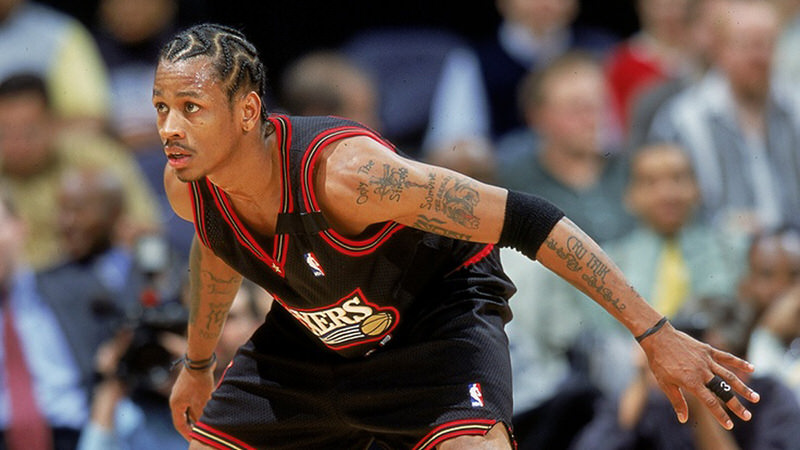
CHAPTER 8 | THE STYLE ICON
Beyond just his signature sneaker line, which introduced a new wave of fans to the Reebok brand, Iverson was also instantly recognized for kicking off countless trends that would take the league by storm. Cornrows. Tattoos. Throwback jerseys. Arm sleeves. Headbands. Custom armbands. Fingerbands, even.
Sure, all of those had been seen in an instance or two throughout history in some form, but it was AI’s collective ensemble of accessories for the sake of personal expression that morphed him into a cultural icon that would soon reshape the look of the entire league.
There are few images from that era as distinctly iconic and culturally significant as Allen’s “Soul On Ice” SLAM cover. Since the NBA lockout was just getting underway and the entire season was possibly on hiatus for good, SLAM veered to the past during the fall of 1998, and launched an “Old School Issue” the following March that was “84% NBA Free!”
It was Iverson’s merging of old school look and modern hip hop style that took things over the top, as he rocked iced out chains, rings, earrings, a bracelet and a watch with his transcendent custom Mitchell & Ness throwback jersey.
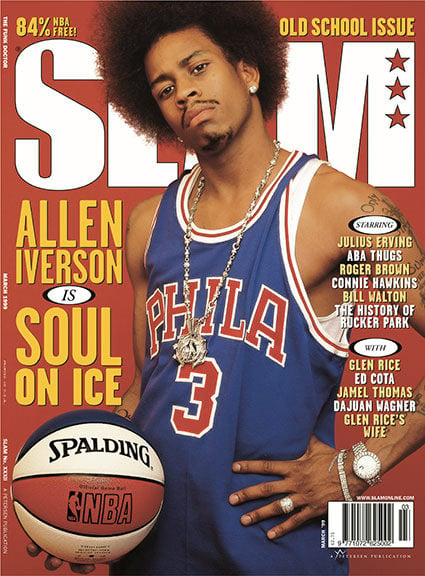
Just as the lockout ended, AI also happened to come back to the court with seven new tattoos. “Hold My Own” and “Only The Strong Survive” were not only mantras Allen lived by, they were also featured in upcoming Reebok footwear and clothing.
Soon enough, we saw players across the league mirror Iverson’s look, creating an entirely new era for the NBA at the turn of the millennium. It was the throwback jersey era that saw one of the biggest surges. In 1998, the little-known company Mitchell & Ness enjoyed $1.5 Million in sales for the year. By 2002, sales had skyrocketed to $23 Million, with a bit of thanks to Allen’s SLAM cover.
As we’d see in the coming years, Iverson’s impact on style would stretch to all pockets of the globe.
***
Que Gaskins: David [Falk] played a big part in helping us to set his marketing up when we first sat down and talked about it. A lot of people thought that we came in and Reebok was the one that created Allen’s look. That we told him to go get cornrows and that we told him to go get tattoos. We didn’t necessarily encourage that. We didn’t go out and say, “Lets put this in our marketing plan and see if Allen can go and become this urban icon.” We always knew that Allen represented the culture, and we always saw that he had that in him inately. Him being the representative of urban culture, that was in him. We didn’t have to market that. If we did market it, we thought that would come across as trying too hard. Why would we try and make him something, when he’s naturally that.
Dennis Page: We didn’t really have formal meetings, we just sat around and bullshitted. [laughs] It was the lockout, so we just thought, “Hey, lets throw him in a retro jersey.” I remember then we asked if he could wear his hair in an afro instead. We pitched it, and he did it, but of course it took hours and hours to get it done. [laughs]
Lynn Bloom, Mitchell & Ness: The NBA started their on-court Hardwood Classic jerseys in the 1996-97 season, so having current players wear retro jerseys was still a relatively new phenomenon. The fact that Allen wore that classic PHILA jersey, inspired by the 1966-67 Championship season, was huge for us. Allen representing his newly adopted city in that way, on the cover of SLAM – that was priceless. The cover hangs in our office and store to this day.
Gary Moore: Once he came back from the lockout with the tattoos and started to dress a certain way and with jerseys, I saw everyone start dressing the same way. I started seeing how Kobe and others in the league were dressing. The younger guys coming in had tattoos, and he changed an entire culture. They embraced it.
Todd Krinsky: It definitely happened quick, and there were some people that were concerned internally at Reebok, saying, “What’s going on?” That started his whole transformation, and he was really expressing himself the way he wanted to, and he wasn’t really caring about the league or what people were going to say. This was Allen wanting to be Allen at the time. It was not 2015, where 80% of the league has tattoos. People were saying, “Oh my god, how’s he going to look in his uniform on the court?” I just said, “Guys, you have to understand. This is who we’re in business with. This is Allen Iverson. It’s the same guy, and kids love who he is because of how he dresses and how he acts. This is the gift and the curse.” For a lot of us that were in the culture, it wasn’t that big of a deal when it happened. But it did make the league nervous, and definitely some people at Reebok didn’t understand it and were concerned.
 Que Gaskins: I looked at him like, “You’re going to rock cornrows?” He was like, “Yeah!” I said, “The NBA is not gonna let you rock cornrows.” That was the worst thing that I could’ve said. We’re about a year into our relationship, and any time you challenge him or tell him he couldn’t do something, that’s exactly what he’s going to want to do. Had I known, I probably would’ve set it up a little differently. He goes, “I’m going to do what I want to do. I’m gonna do me.” Then he threw it back on me, and said, “That’s that corporate shit. If anything, Reebok won’t let you do some shit like that, but the NBA can’t stop me from doing it.”
Que Gaskins: I looked at him like, “You’re going to rock cornrows?” He was like, “Yeah!” I said, “The NBA is not gonna let you rock cornrows.” That was the worst thing that I could’ve said. We’re about a year into our relationship, and any time you challenge him or tell him he couldn’t do something, that’s exactly what he’s going to want to do. Had I known, I probably would’ve set it up a little differently. He goes, “I’m going to do what I want to do. I’m gonna do me.” Then he threw it back on me, and said, “That’s that corporate shit. If anything, Reebok won’t let you do some shit like that, but the NBA can’t stop me from doing it.”
I’m like, “Man, Reebok is the most fair, open company I’ve ever seen. What you mean they won’t let me rock cornrows?” So we basically had this little bet, to see who could rock them and not get in any trouble. He started catching a lot of flak for these fucking cornrows. Just because he’s wearing this hairstyle, he’s being labeled a thug, and he’s this bad guy. I didn’t think he would get beat up in the media like he did for this hairstyle.
Allen Iverson: I remember the backlash. [laughs] I remember the backlash. Honestly, in the moment, I thought nothing of it. It wasn’t a big deal to me, until the aftermath of it all. When people were trying to make a big deal over my hair, I knew the NBA was totally different.
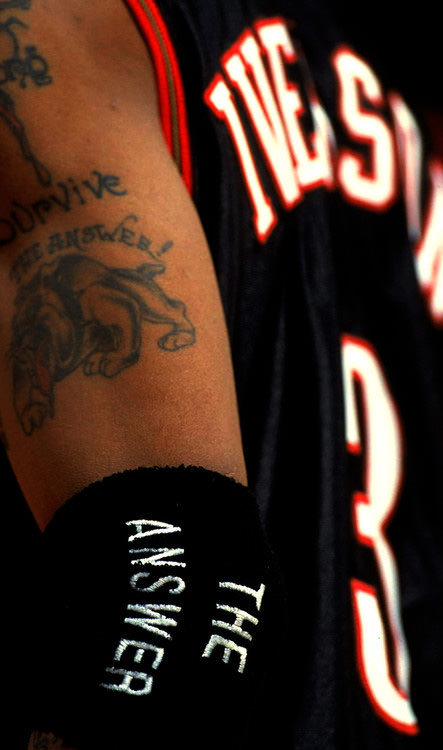
Gary Moore: When he braided his hair, it wasn’t for the reason that people think, it was because the barber kept messing up his haircuts. Instead of going from this barber to that barber and he was going from city to city, he felt like it would be best if he could get a certain style of braid, and wear it the right way and be respected for it. He made people respect braids, and the same thing with tattoos.
Allen Iverson: When I started doing it, I was criticized so much. I was beat up for it, and I was so young. Back then, my skin wasn’t as thick as it is now. So it used to bother me a lot. Even articles and things people used to say, I was so young. Then, I had to grow and learn to understand that that’s the way it’s going to be. A negative story about Allen Iverson is going to sell more than a positive one. Me giving out turkeys, or giving out gifts for Christmas, and stuff like that. Don’t nobody want to hear about stuff like that, when it come to me. They want to hear about the renegade story.
Que Gaskins: It became something that was misunderstood so much outside of the culture. Within the African-American culture, I think people just looked at it as a simple hairstyle of the time. I looked at it like, when hightop fades were in, I had a hightop fade. When 360 waves were in, I had 360 waves. Now, James Harden and people are rocking beards. If I was still young and playing ball, I probably would have a beard too. [laughs]
It was just a look, and a cultural look. Outside of that, people really did try and use it to define Allen’s true character. I ended up rocking cornrows for about ten years, and I just wanted to create another image of what they could be.
I felt like if more people saw me — this guy from Kellogg Business School, who was Valedictorian of his undergrad and a Vice President at Reebok, who was a family man that’s been married for 25 years — if they saw me with that hairstyle, then people couldn’t just say it was a thug thing. Here’s someone that’s clearly not a thug, that just is rocking the hairstyle.
If you look at it now, Kawhi Leonard has tattoos and cornrows, and he’s a great player and a nice and quiet kid. You never hear the word “thug” said about him, and now it’s more accepted. In our community, it was always accepted. It just wasn’t accepted in mainstream America, and that’s where Allen took the beating.
Allen Iverson: All my tattoos are tattoos that I wanted to get, but I couldn’t afford. [laughs] Coming into the league, if I would’ve had money, then obviously I would’ve had more tattoos. [The first bulldog tattoo] was a time where my mom or my dad or somebody gave me $100, and I said, “Well this is what I want to do.” They couldn’t believe I spent it on that, [laughs] but that was something that I wanted real bad.
Lynn Bloom: I think he ushered in a culture of self-expression that hadn’t been prevalent in the league. His tattoos, hairstyles and style of dress all played a part in athletes expressing their style in both their on court and off court looks. Of course there was Dennis Rodman before him, but I think young people could relate to Allen more and he was truly representing their generation.
Allen Iverson: It’s a great feeling to be a trendsetter. I like to think that me being a basketball player is totally different from me setting trends and me allowing guys to be brave enough to just be them. This is who I am, and that’s that. That’s the great part of who I created within myself, to be myself and let people know that I’m cool with that whole aspect of life.
Gary Moore: I used to tell him, “You’re going to mean to people what Martin Luther King and Malcolm X meant to people.” I did not mean that he would be like those people, but I meant that he would change culture. What he thought and what he felt meant so much to so many people, just like those gentlemen did. People cared about what Allen Iverson felt.
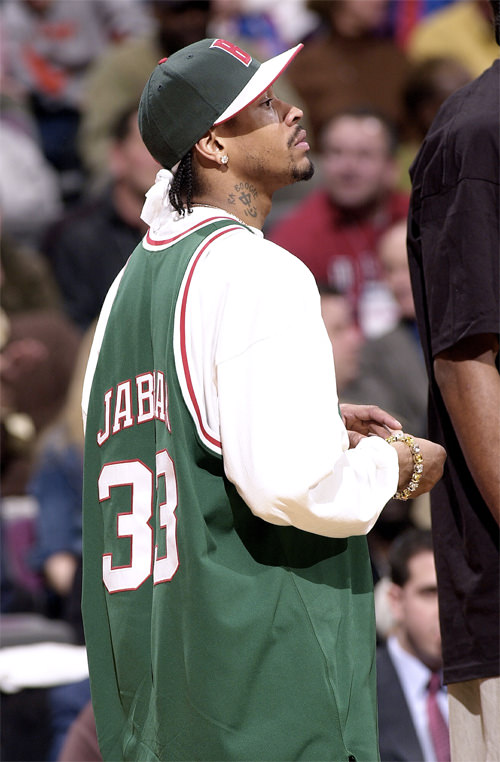
Allen Iverson: I took a beating for it, but the sweet part about it is, now you look around the NBA, and all sports in general, and you see [tattoos]. They felt that it was cool, as far as the athletes. I felt proud that I started something, and people can open up and be themselves. That’s what sports is. Everybody can’t be the same. That’s why fans love certain people and different guys in sports. They have their own originality. If everybody was the same, you would like every player and everything. Wouldn’t no player stand out. It was bittersweet, and I’m happy I took the beating for it.
Todd Krinsky: Hip-hop music was so big at that time, and it was really influencing cultures. If you remember, it was like hip-hop was becoming the universal music genre for inner city kids and suburban kids. It was expanding, and the look was out there, and everyone was wearing baggier stuff. It was pervasive, and he was at the epicenter of that.
He was a basketball player, but he was also wanting to be a rapper, and every rapper wanted to be cool with him. He was just part of that whole cultural push. The fact that he was doing it as a basketball player, it made him so unique. Now, it’s a different world. He created the world that exists now, but back then, it was just so cool to be able to be a rock star that plays basketball. He didn’t really care about any parameters or act like a normal athlete.
On top of that, his game at the time was just so cold and aspirational. He was just crossing guys over left and right, and guys would be falling almost every night. He was in these zones where he was dropping 50 and hitting fadeaway 3s. Even when he was having problems with his coaches, that’s something that kids around the country also go through.
He was the most relatable athlete on the planet at that time. The other thing, even my dad used to say to me is, “I don’t love everything about him, but he gives 110%.” He was old school in that sense, and an older generation still respected him because he would be in the locker room fighting with the trainer to play with a broken finger. He had that old school mentality to fight through. On some level, not his look and his attitude, but his no fear and warrior mentality was something the older generation could respect.
Gary Moore: I knew the Dress Code would happen. I’m one of the people that was not surprised at all. I wondered why it took so long. I knew that the NBA wasn’t going to go for this for too long. When they saw that everyone was adapting to how Allen was dressing, and guys were starting to wear anything that they wanted to wear, I knew that it was coming. I wasn’t at all surprised, and I wasn’t mad, because it needed to happen. That’s how business people are supposed to dress when they’re going to work. These guys were conglomerates and business people, whether they wanted to recognize that fact or not. He was comfortable with what he wore. It wasn’t my cup of tea, but he was fine with it. [laughs] He was just in disbelief there was now a dress code.
Allen Iverson: I was bothered by it, because I felt like they were targeting people that dressed like me. All of the young guys in my generation were starting to feel like, “Well damn, you know, he dress like how he want, and he alright. We been wanting to dress like how we want, but we just felt like we couldn’t.” I think it should be a dress code now. They made a big deal when I was doing it, but some of the stuff these dudes are wearing? [laughs] Come on man. They were picking on me, obviously, if they let these guys wear what they wear now.
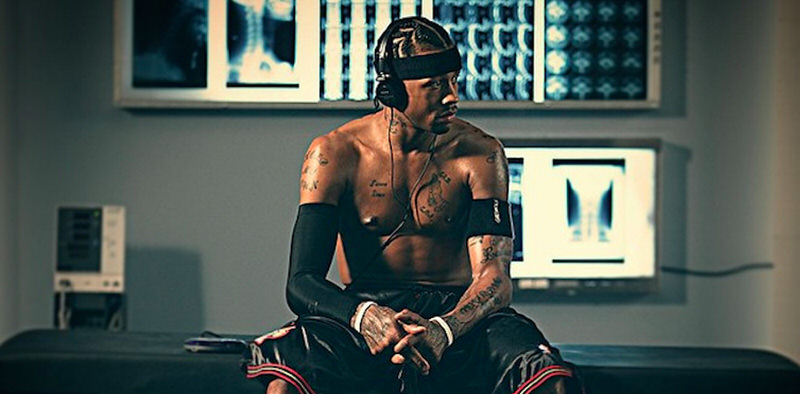
CHAPTER 9 | IVERSON TIME
I distinctly remember the first time I met Allen Iverson, fittingly at the Reebok headquarters. He was 4 hours late. As I’ve come to find out through the years, that wasn’t entirely all that late for him. Gary Moore has said that AI would often joke, “If we weren’t rushing late, it just wouldn’t feel right.”
For everyone that worked closely with Allen during his career, “Iverson Time” was something they certainly got to fully experience.
Que Gaskins: His timing was the most stressful, most difficult and most challenging part of everything that we had to do. It cost us money, and it got to the point after the first couple years, literally I would tell people like Dennis Page, when they wanted to do a SLAM cover, they would come to us for a 10 AM shoot. I’d say, “Listen guys, 10 AM is not gonna happen. If you want him on the cover, we can try to do a 10 PM shoot.” [laughs]
Dennis Page: I remember one cover, we had a call time for 12 o’clock, which was ridiculous already. [laughs] I wasn’t down there in Philly for the shoot that afternoon, and I was back in New York and just about to go to a movie with my wife. The movie was at 8 o’clock that night, and he still hadn’t shown. [laughs] We were always prepared to have the shoot not happen, but somehow he always got it done. He was just on Iverson time, but would always make it happen, and we were happy to have it eight hours late. [laughs]
Todd Krinsky: It’s no secret. I’ve been working with him since the beginning, and for me, it’s like working with a brother. But you don’t always get along with your brother, and sometimes you fight pretty heavy. [laughs] That’s what it became a couple times. He talks about it now like he understands what he did, but back then, he was just very hard to manage. He was on top of the world, he wasn’t respecting a lot of people, and he had no care about time or money. I used to try and figure out how I should come at him. He respects me, so let me talk to him. If I come at him and say, “Yo, Reebok just lost X amount of money,” he would just say, “Man, who cares.” He didn’t value the money. If I said, “Hey, these people are out here and they’ve been waiting for three hours on the set,” he wouldn’t really care about that either. There was nothing that I could really say to get him to relate to make him understand that we just couldn’t operate like that. He was late to everything. He was late to media stuff. He was late to commercial shoots. He’d miss three or four planes sometimes. The day before we’d have a shoot, I would actually have one person that was just ready to book new flights every hour. We would tell him to be somewhere at noon if we weren’t shooting til 4. You’d come up with these little games to make things a little easier.
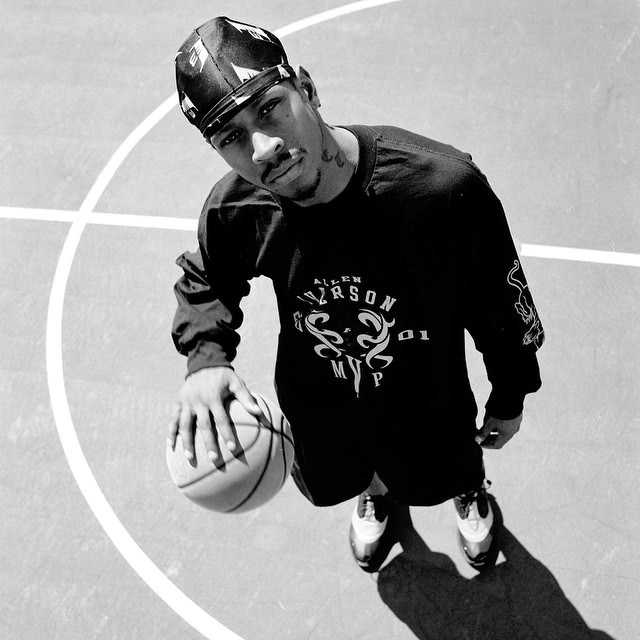
David Falk: I went to see him in Philadelphia in his second season, when they were going to play the Bulls. I know that players are all sensitive about who has first crack with me, so I stayed there for two nights. I told Allen, “You pick which night you want to have dinner, and I’ll deal with Michael the other night.” So he picked Tuesday, which was the first night. I showed up, and no one could find him. I call all his people, and no one can find him. We were supposed to meet at 7, so by 9:30, I’m still in the hotel lobby, and the Bulls actually just arrived. So I took Michael to dinner with a friend of mine, and we go to The Striped Bass, which is this really high end restaurant in Philadelphia. I think the bill was like $3,500 for the three of us. [laughs] The next night, I took Allen out after the game, and it was a party of thirteen people. I said, “Where would you like to go?” We went to TGI Friday’s, of course, and he got popcorn shrimp. [laughs] I think the bill for the thirteen of us was around $275. [laughs]
Que Gaskins: Allen was one of these guys where he definitely was living in his own time world. There were times where we’d get smart, and know that we couldn’t really set anything up for the morning, so lets do something in the afternoon. Lets tell Allen it was a 1 o’clock start. The reality is it may not be until a 4 o’clock start. We’d give ourselves a three hour cushion. His thought process really was, “It starts at 1, I ain’t going to get there until about 3. They’re going to take time to set up and all this stuff.” I’m trying to tell him, “No! They’re already set up.” It was hard for me to explain it to him, but everyone was already working since the morning. Over the years, we’d just tell him a different time. If he got there early, great, and we were all set to get moving on our end. When he came strolling in and thought he was coming in on his own time, well that’d be around when we expected him anyways, so we’d be good to get started.
Todd Krinsky: We had this idea that we were going to take the Question every year, and we were going to do it for the All-Star Game in the home team’s colors. If Allen was playing an All-Star Game in Miami for example, then we’d launch the shoe just in Miami, he’d wear it and it’d be red and black. The year the All-Star Game was in Oakland, in 2000, we did a really bright yellow and navy Question for the Golden State colors. He didn’t like a lot of bright stuff, so I asked him like six times, “You’re gonna wear these?” He was like, “Yeah, I’ll wear ’em.”
So we sell the shoe into Eastbay, Champs, Foot Locker and everybody, and this is the first year of this whole Question strategy for the All-Star Game too. I get to the arena for the East practice, and he’s not wearing ’em. I’m like, “Chuck, you gotta wear those tomorrow. We got our whole marketing plan around this yellow Question, so you gotta wear it.” He’s like, “Aight, aight.” So I get there the next day before the game, and he’s outside of the locker room and he’s got on black and red Answer 3s.
Right away, I’m like, “Man, you gotta wear the yellow ones.” He goes, “They’re too bright. Everyone says they’re too bright.” We sold in 50,000 pairs of this colorway! I’m sitting at the game with all of the buyers from the stores, and I don’t know what to do. I’m running around the locker room, I run over to Ann and I’m begging her, “Ann, you gotta talk to your son!” I’m trying everything, and I couldn’t get him to switch. This was back in the day, so I didn’t have a cell phone. I check my office voicemail after the game, and I’ve got like 50 voicemails and people were just killing me.
Allen Iverson: I was always the type of player that felt like, “You play like you look, and you look like you play.” I always cared about how I looked out on the basketball court. And I cared about matching. I used to give them a hard time when I went to Denver, if the blue didn’t match the blue, or the yellow didn’t match the yellow in the shoe. I’d have a problem all the time. Now, it’s a new wave. Basically, a guy can have a green uniform, and then have red shoes on. That’s the style now, but back then, for me, it was about matching everything up. Then, when they gave me the [All-Star] shoe, and it didn’t match the uniform, I had a problem with it. [laughs]
Todd Krinsky: That was life with Allen, and he would always joke to me, “Hey man, it’s hard workin’ with AI huh?” That was the gift and the curse, cause when you get through those things, on the other side, you’re working with a guy who’s got tremendous heart, and who is one of my favorite people and a very close friend of mine today. By the end of it all, he had one of the most successful franchises outside of Mike in the industry. Everything we went through and all the grey hairs, it was definitely worth it versus if we had gone with someone that was a little easier to work with.
Allen Iverson: The relationship with myself and Reebok, I don’t think you can get any better than that, besides Jordan and Nike. We had a great relationship, and we always put our heads together, and every time at the end of the day, 9 times out of 10, agreed. Everyone ended up being happy. But sometimes, you feel a certain way, and when you’re getting ready to play a big game like that, you always want everything to be right. You don’t want to worry about after it’s over, saying, “Man, I shoulda wore the red ones.”
Que Gaskins: It was just a part of how he grew up. There was a lack of structure. If you watched the documentary, he missed a lot of school and probably never got there on time. He just didn’t have that respect for it. We tried to get him to understand it, but it was hard. One of the things I learned through working with people is that you truly are the average of the five people closest to you. His friends had no real concept of time, cause none of them had real jobs. They didn’t have to be places or be on time, and he had no concept of it, and it just made everyone’s job difficult.
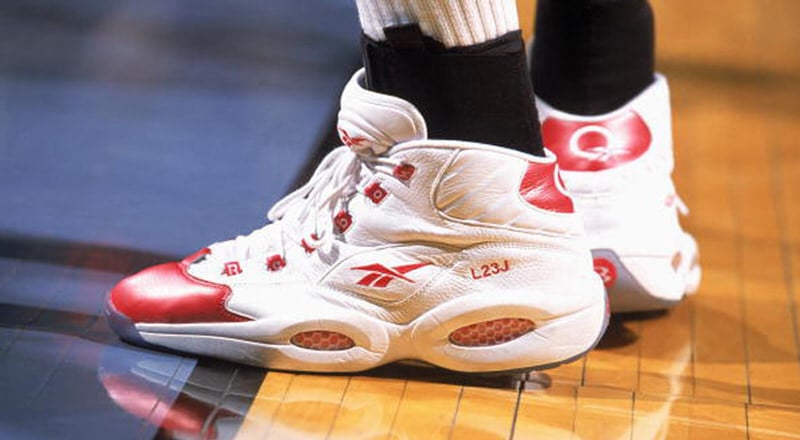
CHAPTER 10 | THE LINEAGE OF THE NEXT GENERATION
“I didn’t want to be Michael or Magic. I wanted to be Allen Iverson.”
Those are the words of LeBron James. Just after the 2001 Finals, LeBron had cornrows and his first few tattoos, all before the start of his junior season of high school.
One of the craziest things about AI progressing through his 40s, is that there’s currently a generation of players in the league who not only grew up watching him play, but grew up idolizing all that he brought to the game.
It isn’t hard to look around the league now and see the players he’s directly influenced.
***
Carmelo Anthony (via Chris Palmer): He changed everything. An entire generation owes him.
John Wall: Allen Iverson was one of my favorite players growing up, for sure. I was small with braids just like him. Then, I finally hit a growth spurt. I have all of Allen Iverson’s shoes. That’s all I played in during my AAU years. I played in the Reebok Questions and the zip-up Reebok Answer IVs. I played in every single Iverson shoe that has ever been created.
Isaiah Thomas: [Watching AI growing up] affected me a lot. He’s a guy that can score and he’s probably the best under-6-footer to ever do it in the game of basketball. Not just on the court, but off the court with his braids and his tattoos too. Most importantly, with his Reebok shoes. They were iconic. They were shoes you could play in and wear with some jeans too. You could always wear them with jeans and then also look good on the court. The Questions are definitely my favorite pair of Reeboks, but I like all the Iversons. They were the best Reebok shoes.
Que Gaskins: I think people will definitely respect the impact he had on the game. If you look at guys like Kyrie, Steph and Russell Westbrook, you can clearly see the impact that Allen has on the game. They all have pieces of his game in them. Culturally, the era that he represented, he was one of the people that made it so that corporations would invest and take a chance with urban culture.
Allen Iverson: That’s the best part of it all. You got your own shoe, but seeing somebody else with them on is totally different. I’m not talking about your family or your friends, cause they’re gonna wear ’em regardless. But just seeing the fans or other players wear ’em, and to go even further, the people that’s not even fans of you, but like the shoes. That’s one of the best feelings ever. The fact that everyone still wants them this many years later is incredible.
Todd Krinsky: From the way he played to the way he dressed, Allen made it okay for all these guys to express themselves on the court. Allen tells a story that his last year in the NBA, he couldn’t walk back to the locker room with a pair of shoes because every single young player in the league would ask him for a pair of shoes. I’m talking about Rookie of the Year winners, Brandon Jennings, all these guys would go up to him and ask for a pair of shoes. I think even Allen himself recently said that he hadn’t really started to realize his legacy until his last few years of playing.
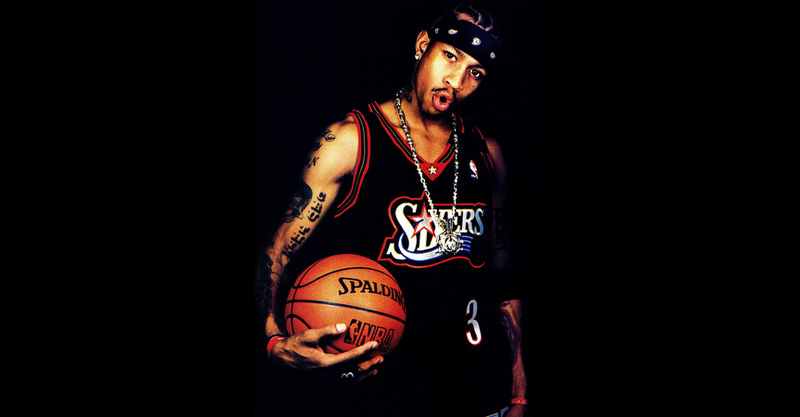
CHAPTER 11 | THE LEGACY & FUTURE
Now that Allen is entering the next phase of his life, having been inducted into the Basketball Hall Of Fame in 2016, there’s no telling what he’ll be getting himself into just yet. All that’s certain is the tremendous impact he’s left on the league, pop culture and the sporting world as a whole.
As he prepares to look at the next chapter, he’s able to reflect on the journey that’s gotten him this far, while keeping a low profile and enjoying his daily dad duties. Others still think he can make another push into the entertainment and endorsement worlds. More than anything, he’s in a good space according to those close to him, grateful for the recognition and praise that’s come his way, and excited for what’s next ahead.
***
Allen Iverson: I mean, it feel real good, just being the fact that [there are] guys that came up with me and supported me throughout my career. I think the best feeling is the younger kids that you wouldn’t expect to want the Questions and to check for ’em. That’s the best feeling in the world for my son and his friends to want them, and the style never left. Growing up, I always was a big shoe fanatic, and to be second to Michael Jordan in selling shoes, it’s the biggest thing in the world and it’s a blessing.
David Falk: I think if you look at the history of the shoe industry, and you take Jordan out, Iverson may be the most interesting and iconic endorser of a shoe, other than Michael. There’s no one on the same level as Michael, but if you take him out of the equation, Iverson really got Reebok entrenched in basketball, and the shoe did well during the two years that we represented him. I can’t really speak to the time after that, but it was an enormous deal for Reebok to get a player of his caliber.
Dennis Page: He’s like Rocky. He’s so relatable, and that’s what makes him so special. You can’t relate to Kobe or Mike necessarily if you’re a kid, and that’s what’s going to make Steph Curry so great too. They’re so relatable. If you’re 6’1” and you work at it a lot, you can be good like that. Allen was the underdog.
Brandon Richard: For a sports hungry area with no local pro teams, AI was our rooting interest for 14 seasons. He might not have been the ideal role model, but there wasn’t a kid in Hampton and Newport News that didn’t look up to him. Nothing came easy for him.
Allen Iverson: The best part about it all, with not playing basketball or whatever I’m getting into after basketball and still being relevant, it’s a great thing for kids to want to wear your shoe regardless, even if they don’t see you every day. You know how it is – out of sight, out of mind – people forget very fast. I feel like what I contributed to the NBA and to basketball, was so much that it can’t be forgotten. Yeah, you can bring back retro shoes, but just the name being there, young kids are knowing the name. A 5-year old kid will know who Allen Iverson is; that’s a great thing. You’re not flashed on the TV every night, and your name still holds weight, your shoe still sells and your brand is still there. That’s the most exciting part about it, just knowing that I gave so much to the game and to my culture, that I’ll always be relevant in people’s eyes.
Todd Krinsky: We were in Atlanta with Allen and his oldest son Deuce, who’s like 15 now. We had an iPad with highlights of Allen, and Deuce was watching them, like, not even breathing. He was just mesmerized. Even though he’s watched his dad play before, it’s even incredible to watch it now. He was saying that his friends and a lot of people in that generation don’t know him, which is crazy, because he’s influenced every single kid that’s in the league now.
Que Gaskins: My frustration with AI was that I felt like he never really evolved into the businessman that I thought he was capable of becoming. Because I was there, driving the car both figuratively and literally, he really had the world in the palm of his hands. There was a time when my phone would ring, and it’d be people like Jay Z calling, or all of the heads of the music labels.
Gary Moore: I just don’t think that he really grasped the whole idea of his impact. I don’t think he fully understood what he meant to so many people.
Que Gaskins: I remember when Spike Lee was trying to shoot the movie “He Got Game.” He wanted Allen to play the role that Ray Allen ended up playing. I said, “This is a role you should really consider.” His reasoning was that it was going to be shot after his rookie year, and he looked at it like, “Yo, this is my first summer break. I want to spend this summer with my friends and my family.” Spike made it very clear that if he did the movie, he would be on set every day for most of the summer. He wouldn’t really have a summer. I kept trying to beat him in the head to want to do it, and then he just said, “If I wanted to act, I would’ve acted. I don’t play ball cause I want to act. I’m not playing ball so I can go rap. I’m not playing ball so I can go start a clothing line. I play ball cause I love to ball.” He didn’t see it at that time. He knew what he wanted and he was true to who he is. He just loved to ball. He had told me that early in our relationship, and it shaped how he ended up becoming the person he is.
David Falk: When I talk to companies about players, and they say they want to sign this guy or that player, who really has an impact on sales? I would say that after Michael, he’s on his own level and I’m not sure there’s ever been a player that’s had a bigger impact on sales, but Allen had such a unique appeal and a tremendous impact as well. I just read the other day that Kobe signed with William Morris and they’re going to work on his post career stuff. If I saw Allen tomorrow, I’d tell him to hire a really smart marketing team to take advantage of his appeal. He still has an appeal that I think he can make a lot of money from. Perhaps even more today because of the tremendous popularity of hip-hop culture. I think Allen is very marketable right now – I do.
Que Gaskins: There were people around the world, any place we went, he was adored and he was someone that people wanted to touch. I just wish that he would’ve been more of a visionary in terms of understanding the power of his brand. Because he always looked at it as just being himself, he never was able to step outside of himself and look at it as a business or as a brand. Another thing that I wanted him to do was the Brandy and Monica video for “The Boy Is Mine.” I just knew it was going to be a huge song. They wanted Allen to play the lead role in that video, and he wouldn’t do it.
Todd Krinsky: I still think back to when I first met him. He was 20 years-old and I was 26. He was just a kid. Now, he’s in his 40s, a few years out of the league, and he’s got a big family and it’s amazing. It’s very surreal that all this time has passed. He’s definitely not the normal ex-athlete. He’s not going to be an in-house studio analyst. He’s not going to do play-by-play for the Sixers. He’s not going to be an assistant coach.
He’s beloved, and he’s in a good spot now and has tremendous kids. He’s got a good group of close friends that were all with him at the beginning and that have his best interests at heart. He’s in a good space right now, and I don’t think he fully knows what he wants to do, but there’s a couple things that are going on that could be interesting on the entertainment side. People still want to work with him, and I get a lot of people still calling me about him. Right now, he’s just spending time with his kids and he likes to fish.
Que Gaskins: I just wish he would’ve evolved into the businessman that I thought he was capable of becoming. I really do think he could’ve been the first billionaire athlete, just because he was able to connect with people on so many different levels. He could’ve been selling hair products, champagne and tequila or whatever it is that Puff is always selling. [laughs] He was on that level.
He could’ve sold water, clothing, cars, jewelry, music, movies and all kinds of stuff. He could’ve been the first billionaire athlete, hands down, no question. If you look at Puff, he’s got water, vodka, a TV company, clothing and that could’ve been AI, all day, and then some.
Todd Krinsky: A few years ago if I’d have told him we’re bringing back the Question, he’d be like, “Alright, cool.” Now, he’s like, “How many colors are we going to do? Where are we selling it? Are we selling it outside of the US?” He asks a lot of the right questions. He’s a lot more aware of his legacy not only on the court but in the shoe game as well, because he has one of the longest running franchises in the shoe game and now he’s interested in the legacy of that.
David Falk: I’ve always liked Allen, and I’ve always been a fan, and it’s interesting with him now in his 40s, because it’s so hard to believe. I really hope that he can translate his tremendous popularity into opportunities for himself.
Brandon Richard: He’s been out of the spotlight for some time now, but the bond between Iverson and the Hampton area remains strong. He always comes home for charity events and appearances. Kids who weren’t around for his best years still idolize him because of his continued presence in the community and the stories that have been passed down.
Gary Moore: He wants to really help to empower the generation that’s coming up now. Allen is going to adopt a couple of AAU teams in Virginia, he’s going to have teams in Texas, in Philadelphia and possibly in Washington DC. His goal is to see if he can impact the next generation in a positive manner as much as possible. He wants to let kids know that there is reason for renewed hope, in spite of everything that you’re hearing out in the streets. He’s interested in both team and player development, and also in showing these kids that there is a business outside of basketball.
additional reporting with Todd Krinsky by Ian Stonebrook and John Wall by George Kiel III
